

Self-introduction for Students [With Sample Intros]
- Updated on Jan 13, 2023
- shares
You would want to make a good impression on your friends when you introduce yourself on the first day in class at your school or college – or at some other gathering. Wouldn’t you?
A small note before we dive into thick of things: Self-introductions can be context-driven, implying that because of unique situation you’re in, you may have to customize some part of the introduction. So, feel free to add or subtract to what’s covered here.
What to include in self-introduction?
Is there a format (for the introduction) to follow? The organizer, for example, may ask to include your name, place you come from, and your hobbies in the introduction.
If there is a format, follow it, but feel free to venture into areas that aren’t included in the format if they provide a more complete picture of yours.
You may include following in your introduction:
1. The start
You can start with the obvious – your name.
But that’s a common start. You can be bit innovative by starting with an attention-grabber. Watch the beginning of this video on marketing to get a feel of what I’m saying (watch the first 15 seconds):
Neil didn’t start with his name. He started with things that will grab people’s attention immediately and came to his name later on.
You can follow the same strategy to stand out among your classmates, most of whom would be following the standard ‘name first’ approach. You can start with a unique experience or a peculiar fact about your city or your uncommon hobby. The first sample intro (later in the post) follows this strategy.
More resources on conversations and introductions:
- How to introduce yourself in different settings?
- How to say ‘thank you’?
- How to respond when someone asks ‘how are you’?
2. Where are you from?
Mention the city you come from. You may add a sentence or two about the city as well if there is something interesting to talk about. Maybe the city is known for historic monuments. Maybe it’s known for natural resources.
And if you’ve lived in multiple cities, you may briefly mention the names and, as mentioned above, a sentence or two on the most interesting of them.
3. Where did you last attend the school?
If you recently moved to a new school (or college) and are introducing yourself there, you can briefly talk about your last school. Are there any interesting facts about your last school? If yes, mention them. Maybe it was established a long, long time ago. Maybe it has produced few famous alumni.
If you’re continuing in the same school, you may mention how many years you’ve been studying there.
4. Interests, hobbies, and achievements
What are your interests and hobbies?
Playing a sport? Traveling? Hiking? Reading? Kite flying? Or something unusual, say bull fighting?
Go into details if you’ve pursued the hobby with serious interest. For example, if you’re into reading, mention what genres you read, your favorite books, your favorite author, and how reading has affected you.
Don’t forget to mention your participation in extracurricular activities in school, if you did. Don’t forget to mention any significant achievements you’ve had?
5. Which stream/department/subject have you enrolled in?
You can briefly talk about which subjects (math, science, arts, commerce, biology, and so on) you’ve picked or you intend to pick in future. Optionally, you may also mention why you made the choice you have. Was it because you love it? Was it because it’ll help you achieve your career goals?
If you’re a college student, you can mention the department you’ve enrolled in. Are you in Arts, Commerce, Mechanical Engineering, Science, or Economics?
This doesn’t apply though if you’re introducing yourself to students who’re all from the same stream/department/subject.
6. Do you’ve clarity on interests/goals you want to pursue in future?
If you’re in K-12, you may not have seriously evaluated what career path you want to follow, and that’s fine. But if you’ve certain career aspiration and if you want to talk about it, you can. Some want to become engineer. Some, astronaut. Some, doctor. Some, model. Speak out what you aspire to become.
Most college students though have more concrete idea on post-college career. If you’ve decided the career path you want to pursue after college, you can share it with your classmates. You never know few of your classmates harboring same career aspirations may just approach you to be friends. You may also mention professional clubs you want to join to hone your skills.
Leave feedback on this post
Was anything not explained well in this post? Was any topic not covered? Do you have any other suggestion? Your feedback will help improve this post for you and for others.
( Note : In the first field below, simply copy-paste url/link of this post from the search bar. In the second field, feel free to refer to parts of this post to explain.)
Participate in a short survey
If you’re a learner or teacher of English language, you can help improve website’s content for the visitors through a short survey.
7. Where can you help others?
If you’ve a strength others in your class can benefit from, feel free to share it. For example, if you’re good in dancing, you can offer to teach the ropes to anyone interested. If you’re strong in a particular subject that is part of your syllabus, you can offer to help others in that subject.
If people know of your strengths, they’ll readily approach you when they need help. This is an easy way to make friends in college. And if you think helping others may be a time waster, you should remember that you too may need help in areas where others are stronger.
This is also a good stage – by offering help – to finish your intro. (See the first sample intro.)
Should I talk about my family?
Avoid it unless the format of the intro requires you to talk about your family as well. You need not go into what your parents do and which class your siblings study in.
Should I mention my last year’s grades?
You shouldn’t unless specifically asked to or others are mentioning it. Top grades can lend a snobbish air to your intro, even if you’re otherwise. Students may make an impression that you’re flaunting your grades, even if you aren’t.
Remember, the primary goal of your intro is to make friends, find people with shared interests.
Four do’s and don’ts when introducing yourself
1. listen to other intros.
Listen to intros that come before yours. If you can refer to someone else’s point or two seamlessly in your intro, you’ll impress people around.
2. Practice, but don’t cram
People often go blank on some of the points or get nervous when they stand up to speak. The best long-term way to overcome this is exposure to such speaking experiences . But in the immediate term, practice what you want to say few times (don’t cram though) to increase your odds of speaking with confidence.
3. Appear confident even if you’re not
After the presentations by executives and entrepreneurs (presumably confident speakers) as part of an executive program at Harvard University, Carmine Gallo , one of the judges, asked them how their presentations went. He heard following comments:
“I was so nervous. I was shaking.”
“I forgot what to say about a slide.”
“I stumbled over my words.”
“I totally lost my place.”
But, no one in the audience spotted those mistakes.
This phenomenon is called spotlight effect , which in nutshell means that people overestimate how much others are noticing their actions and appearance.
What’s the lesson?
If you’re nervous or you make few mistakes, don’t let them rattle you. Most won’t even notice them. Caroline Goyder captures this sentiment aptly in her book Find Your Voice: The Secret to Talking with Confidence in Any Situation :
When you dive into contribution [speaking], and move beyond the anxious competing, you realize that all the worry was such a waste of time. No one is ever judging you as harshly as you judge yourself. Because the truth is that most people are thinking about themselves.
But if you let nervousness and mistakes overpower you, you may make a mistake or display body language that will be noticed by all. And once you’re through the first few lines in your intro, your nerves will start easing.
So, stay composed and carry on. Many in the audience in fact wouldn’t even be listening to most introductions, as they would be busy silently rehearsing their own lines.
4. Make eye contact and be enthusiastic
Make eye contact with other students while speaking. Don’t fix your eyes on a familiar section of the audience. Move your eyes around. And, last but important, your voice and body language should show enthusiasm.
Here are few sample self-introductions for you to get a hang of how they’re done:
Sample self-introductions
Introduction 1
I once spent an entire night in a dense forest with a friend. Well, this act was not to show off how brave I was, but it was forced on me… by my foolishness. During a trek in [name of the region], I and a friend got too adventurous and strayed from our regular route despite instructions to the contrary by our trek guide. We got lost. We survived somehow (that’s a story for another day), but I haven’t given up on my adventure streak and love for outdoors.
Friends, I’m [your first name] and I love outdoors. I’ve been to treks in Himalayas on multiple occasions. These outdoor expeditions have also forced me to learn basic cooking. Well, I don’t boast of cooking dishes you’ll relish, but yes when you’re dying of hunger in the middle of night, you can count on me. I also love cycling long distances – 20+ kilometers in a stretch – and I can manage singing which some may find intolerable.
I’m from [name of the city]. It’s not a big place, but it somehow exists on the map. I’m really excited to be here. I look forward to having some fun, making friends, and building myself up for college. If you’re organizing any outdoor event in future, you can always count on me for help.
Thanks for giving me this opportunity to introduce myself.
Introduction 2
My name is [your first name]. I’m from [name of the city] where I finished my schooling last year from [name of the school]. Is there anyone here from my city? (Changes tack to engage with the audience.) OK, few.
I like watching movies, at least once a month. I play basketball on weekends and chess whenever I get time. I’m into reading thriller novels as well, Dan Brown being my favorite novelist.
I’m happy to step into college life, which provides more freedom and where, finally, I don’t have to come in a uniform. Post-college, I aspire to work in consulting industry.
I’m particularly strong in Excel worksheets and creating well-designed banners and documents. If anyone requires support in these areas, I’ll be glad to help. I look forward to meeting each one of you in the coming days.
Thanks. Have a great day.

Anil is the person behind content on this website, which is visited by 3,000,000+ learners every year. He writes on most aspects of English Language Skills. More about him here:
15 Comments
This really helped me… Thank you so so much.
Thank u….this is quite helpful to overcome my nervousness and get into action..Cheers?
Man, I was so nervous about my interview for school admission. But after reading this, I felt comfortable. Thanks, this was a great explanation.
It helped me a lot. Thank you so much. It was like I was the center of attraction. Thank you again.
Thanx…. It really helped on my first day of college.
Dude, this is another level. Thanks a lot.
Thanks a lot. It was useful. Now, I should be able to introduce my self without nerves ????
Thank you. Now I get some ideas for self intro and thank you for your brief explanation.
I was a little nervous about my varsity first introduction and my confidence increased after watching it.
Intro 2 was like fire…. It helped me a lot, thanx!!
Thanks, dude!!!! I am a school-level student and the introduction part really helped me.
I have a virtual introduction meeting with my seniors in college. I am so nervous about it. This piece is so helpful. Thanks.
Excellent. I like this a lot. I searched for this type of introduction on many websites, but this post is so interesting and good enough to impress my teacher and classmates.
My name is Yeabkal Solomon. I’m a first year student at Arba minch University. It helped me when I was gave my oral presentation.
I was very scared. I was really scared. Thank you very much for helping with the interview. It was very helpful for me
Leave a Reply Cancel Reply
Your email address will not be published. Required fields are marked *
Name *
Email *
Add Comment *
Post Comment
This site uses Akismet to reduce spam. Learn how your comment data is processed .

Self-Introduction Essay
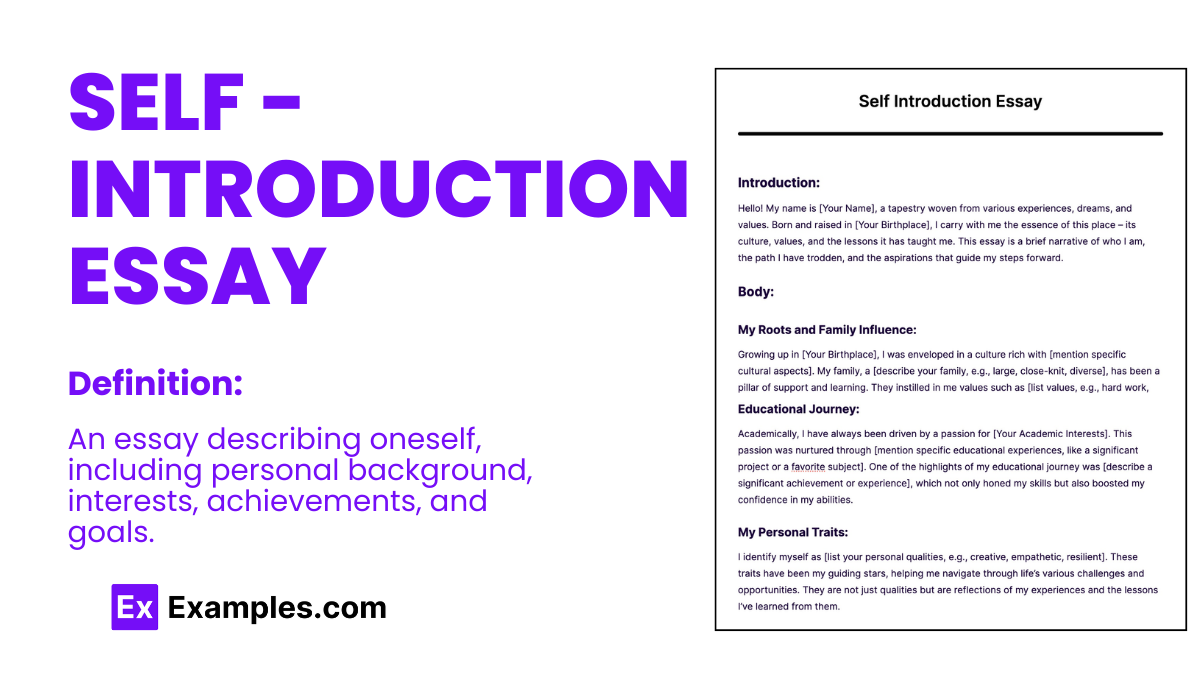
A Self Introduction Essay is a window into your personality, goals, and experiences. Our guide, supplemented with varied essay examples , offers insights into crafting a compelling narrative about yourself. Ideal for college applications, job interviews, or personal reflections, these examples demonstrate how to weave your personal story into an engaging essay. Learn to highlight your strengths, aspirations, and journey in a manner that captivates your readers, making your introduction not just informative but also memorable.
What is Self Introduction Essay? A self-introduction essay is a written piece where you describe yourself in a personal and detailed way. It’s a way to introduce who you are, including your name, background, interests, achievements, and goals. This type of essay is often used for college or job applications, allowing others to get to know you better. It’s an opportunity to showcase your personality, experiences, and what makes you unique. Writing a self-introduction essay involves talking about your educational background, professional experiences if any, personal interests, and future aspirations. It’s a chance to highlight your strengths, achievements, and to share your personal story in a way that is engaging and meaningful.
Do you still remember the first time you’ve written an essay ? I bet you don’t even know it’s called an “essay” back then. And back then you might be wondering what’s the purpose such composition, and why are you writing something instead of hanging out with your friends.
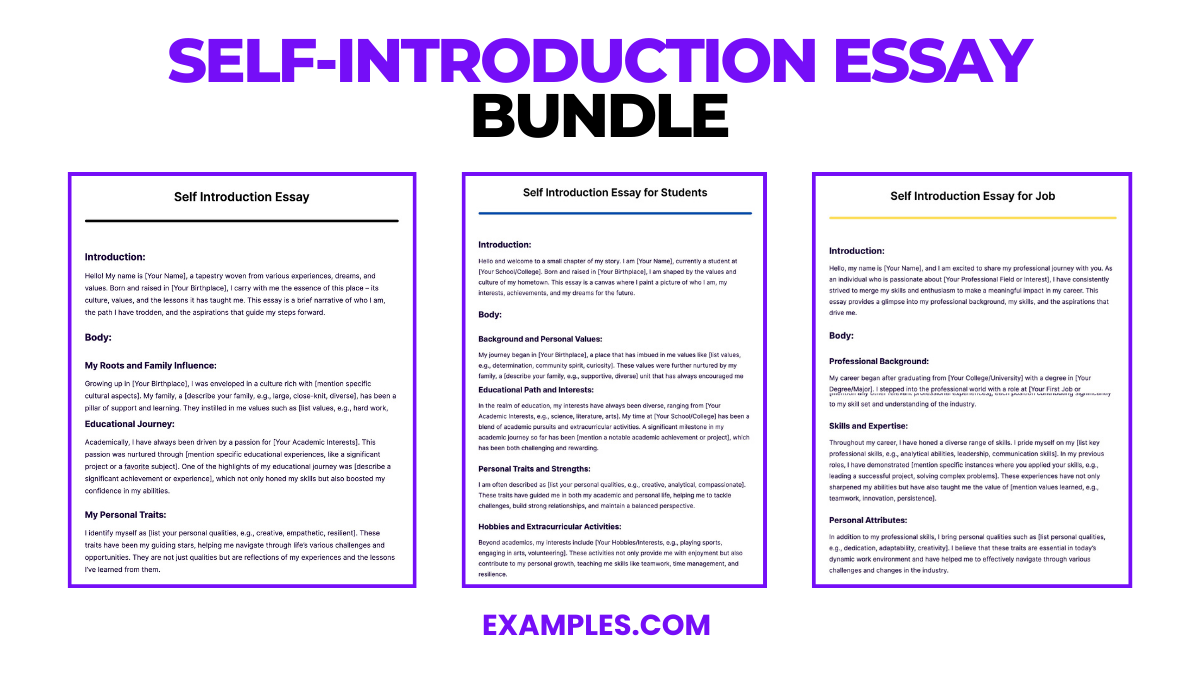
Download Self-Introduction Essay Bundle
Now, you probably are already familiar with the definition of an essay, and the basics of writing one. You’re also probably aware of the purpose of writing essays and the different writing styles one may use in writing a composition. Here, we will be talking about self-introduction essay, and look into different example such as personal essay which you may refer to.
Self Introduction Essay Format
Introduction.
Start with a hook: Begin with an interesting fact, a question, or a compelling statement about yourself to grab the reader’s attention. State your name and a brief background: Share your name, age, and where you’re from or what you currently do (student, job role).
Educational Background
Discuss your current or most recent educational experience: Mention your school, college, or university and your major or area of study. Highlight academic achievements or interests: Share any honors, awards, or special projects that are relevant to your personality or career goals.
Professional Background
Mention your current job or professional experiences: Briefly describe your role, company, or the type of work you do. Highlight relevant skills or achievements: Share experiences that showcase your abilities and contributions to your field.
Personal Interests and Goals
Share your hobbies or interests: Briefly describe activities you enjoy or passions you pursue outside of work or school. Discuss your short-term and long-term goals: Explain what you aim to achieve in the near future and your aspirations for the long term.
Summarize your strengths and what makes you unique: Reinforce key points about your skills, achievements, or character. Close with a statement on what you hope to achieve or contribute in your next role, educational pursuit, or personal endeavor.
Example of Self Introduction Essay in English
Hello! My name is Alex Johnson, a 21-year-old Environmental Science major at Green Valley University, passionate about sustainable living and conservation efforts. Raised in the bustling city of New York, I’ve always been fascinated by the contrast between urban life and the natural world, driving me to explore how cities can become more sustainable. Currently, in my final year at Green Valley University, I’ve dedicated my academic career to understanding the complexities of environmental science. My coursework has included in-depth studies on renewable energy sources, water conservation techniques, and sustainable agriculture. I’ve achieved Dean’s List status for three consecutive years and led a successful campus-wide recycling initiative that reduced waste by 30%. This past summer, I interned with the City Planning Department of New York, focusing on green spaces in urban areas. I worked on a project that aimed to increase the city’s green coverage by 10% over the next five years. This hands-on experience taught me the importance of practical solutions in environmental conservation and sparked my interest in urban sustainability. Beyond academics, I’m an avid hiker and nature photographer, believing strongly in the power of visual storytelling to raise awareness about environmental issues. My goal is to merge my passion for environmental science with my love for photography to create impactful narratives that promote conservation. In the future, I aspire to work for an NGO that focuses on urban sustainability, contributing to projects that integrate green spaces into city planning. I am also considering further studies in environmental policy, hoping to influence positive change on a global scale. My journey from a curious city dweller to an aspiring environmental scientist has been driven by a deep passion for understanding and protecting our natural world. With a solid educational foundation and practical experience, I am eager to contribute to meaningful environmental conservation efforts. I believe that by combining scientific knowledge with creative communication, we can inspire a more sustainable future for urban areas around the globe.
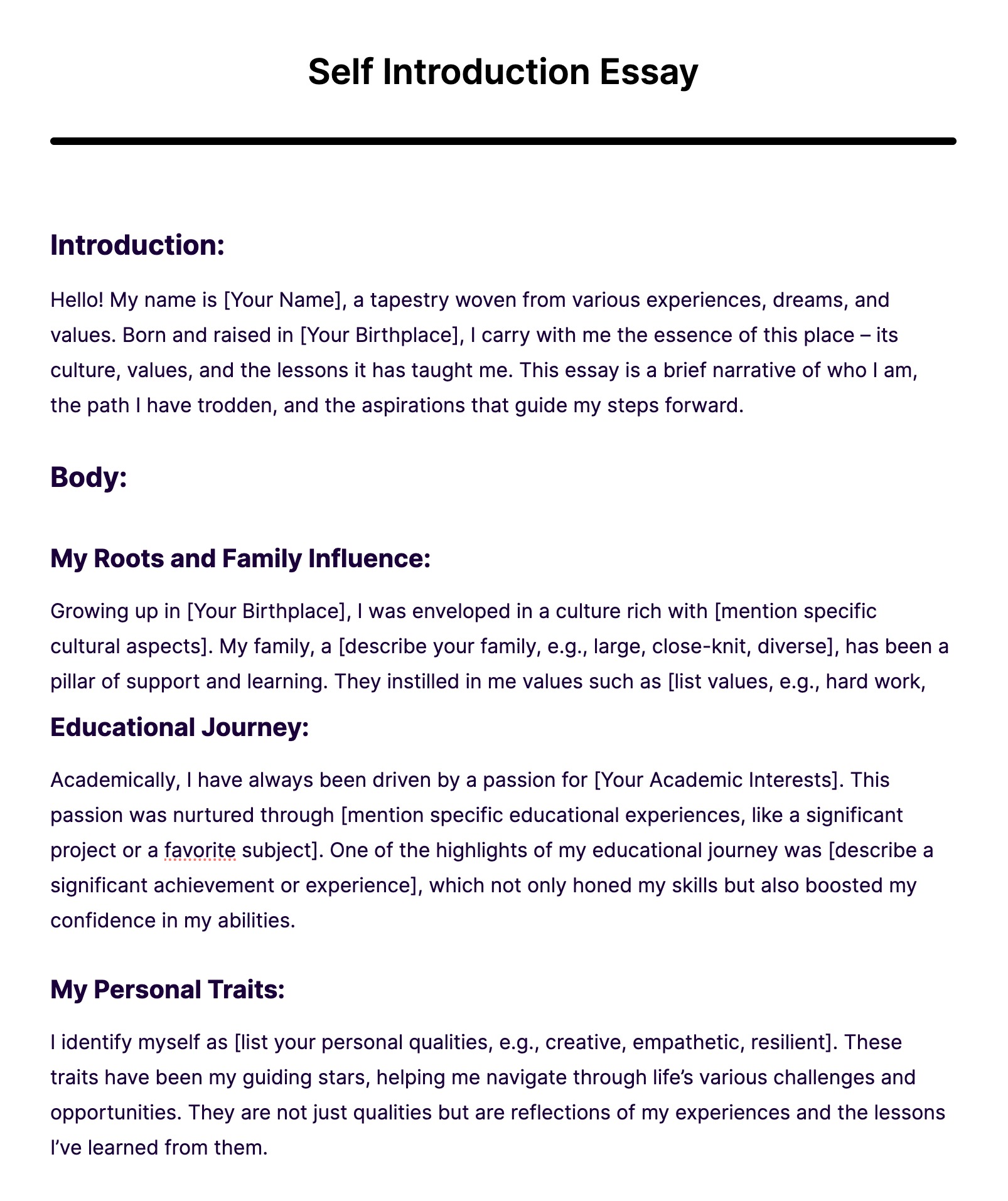
Self Introduction Essay for Job

Self Introduction Essay for Students
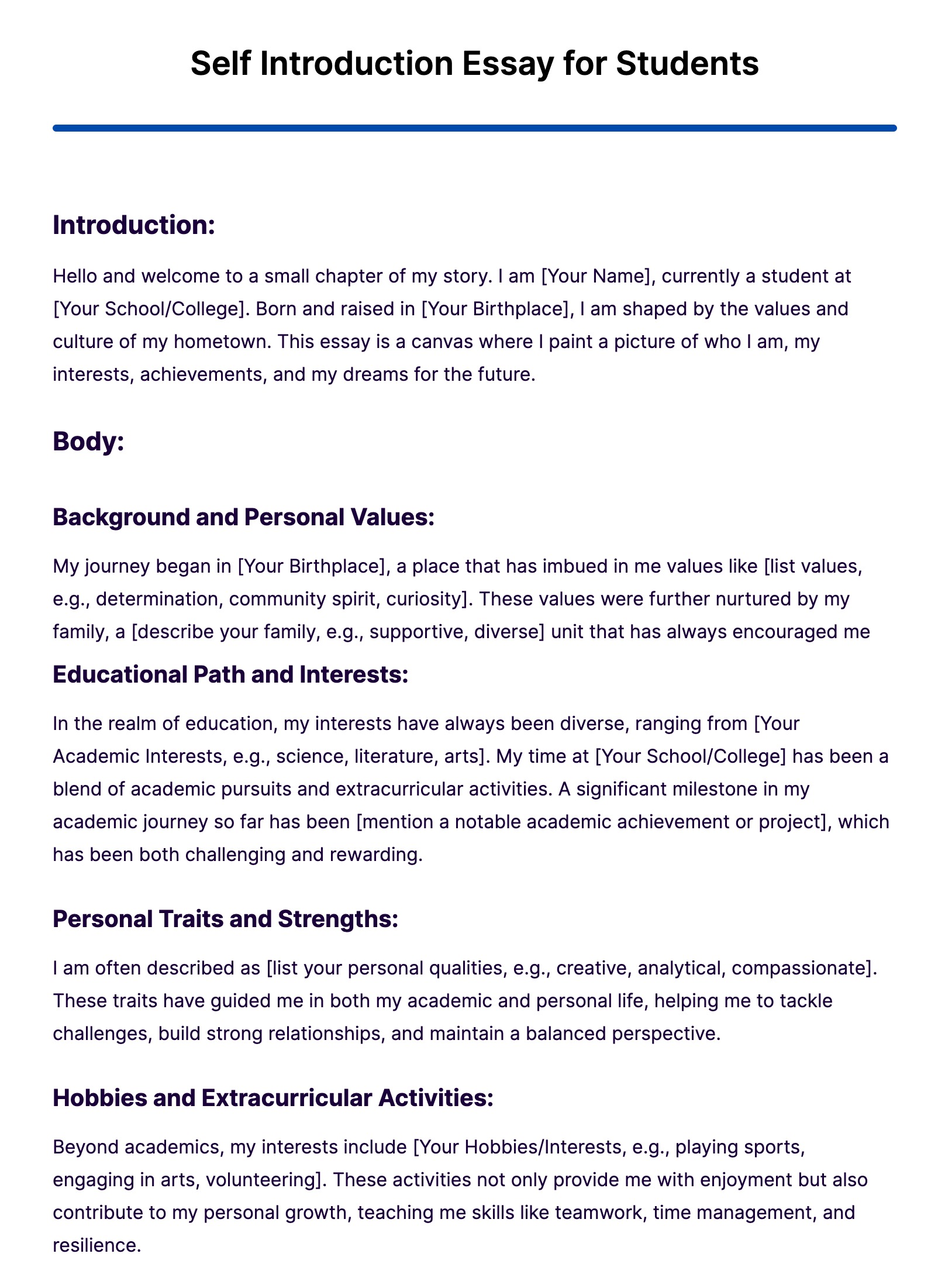
Self Introduction Essay Example

Size: 119 KB
Self Introduction For College Students Example

Size: MS Word
Simple Self Introduction For Job Example

Size: 88.4 KB
Free Self Introduction For Kids Example
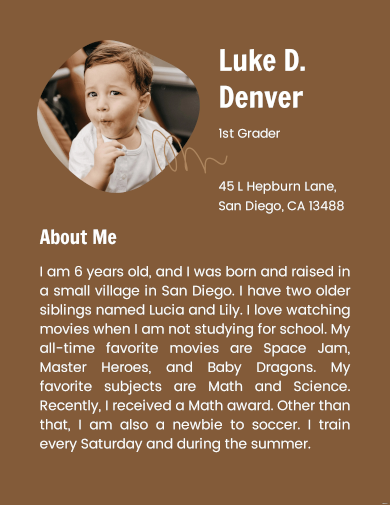
Size: 123 KB
Simple Self Introduction Example
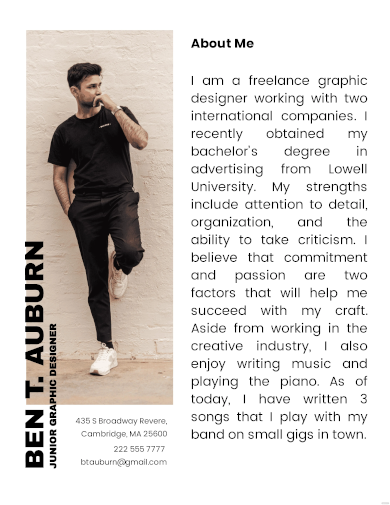
Size: 178 KB
Self Introduction For Freshers Example

Size: 96.2 KB
Free Self Introduction For Interview Example
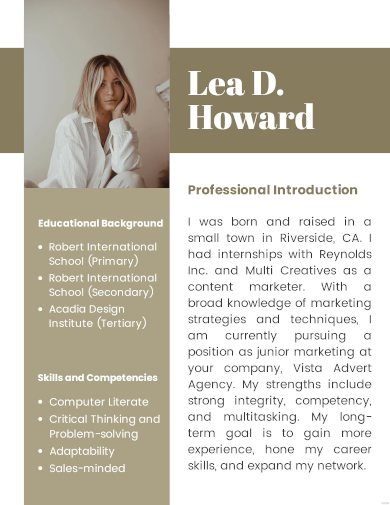
Size: 129 KB
Company Self Introduction Example
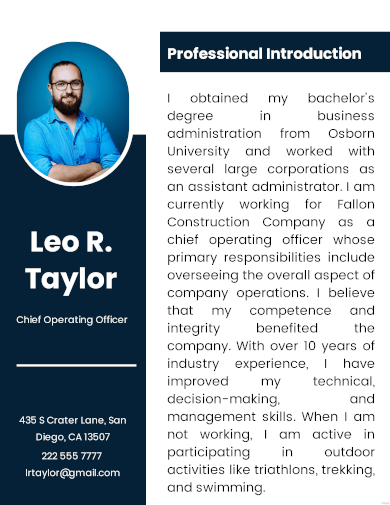
Size: 125 KB
Self Introduction For First Day At Work Sample

Size: 124 KB
Sample Self Introduction for Scholarship Example
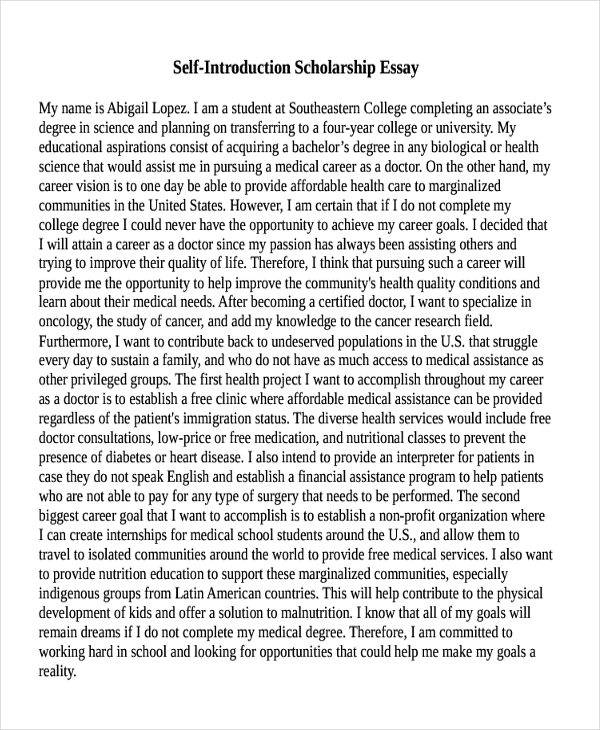
scholarshipsaz.org
Size: 33 KB
Free Self Introduction Sample Example
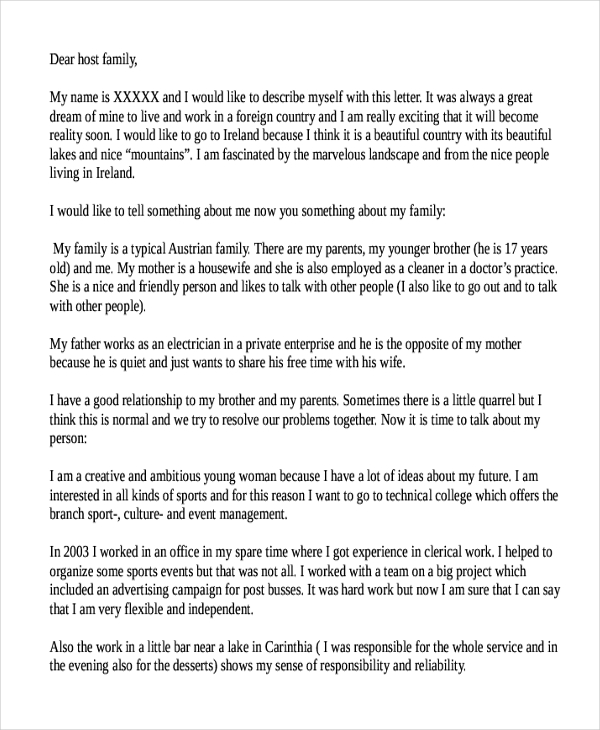
au-pair4you.at
Size: 22 KB
Creative Essay for Internship Example
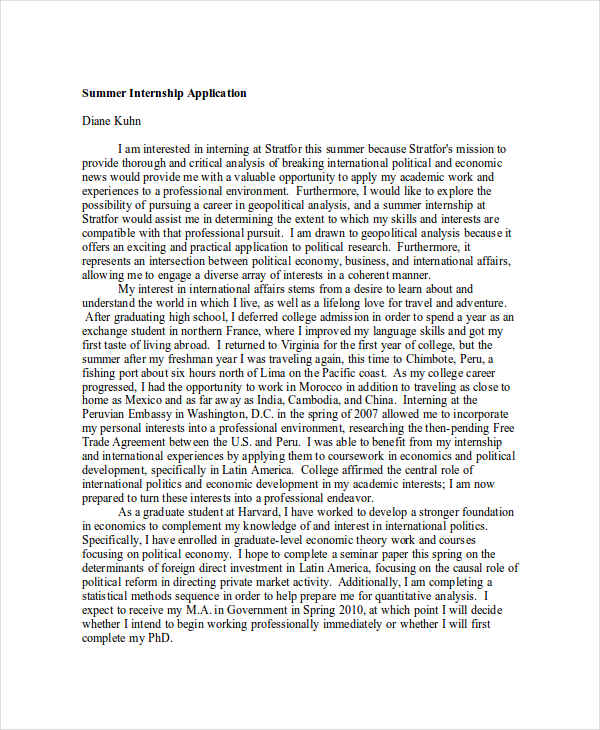
wikileaks.org
What to Write in a Self-Introduction Essay
A self-introduction essay, as the name suggest, is an part of an essay containing the basic information about the writer.
In writing a self-introduction essay, the writer intends to introduce himself/herself by sharing a few personal information including the basics (e.g. name, age, hometown, etc.), his/her background information (e.g. family background, educational background, etc.), and interesting facts about him/her (e.g. hobbies, interests, etc). A self-introductory essay primarily aims to inform the readers about a few things regarding the writer. You may also see personal essay examples & samples
How to Write a Self-Introduction Essay
A self-introduction essay is, in most cases, written using the first-person point of view. As a writer, you simply need to talk about yourself and nothing more to a specific audience. You may also like essay writing examples
A self-introduction essay can be easy to write, since all you have to do is to introduce yourself. However, one needs to avoid sounding like a robot or a person speaking in monotone. Of course, you need to make the composition interesting and engaging, instead of making it plain and bland. This is probably the main challenge of writing a self-introduction essay, and the first thing every writer needs to be aware of.
Free Essay Outline Worksheet Example

englishwithhallum.com
Size: 40 KB
Free Interesting Self Introduction for Student Example
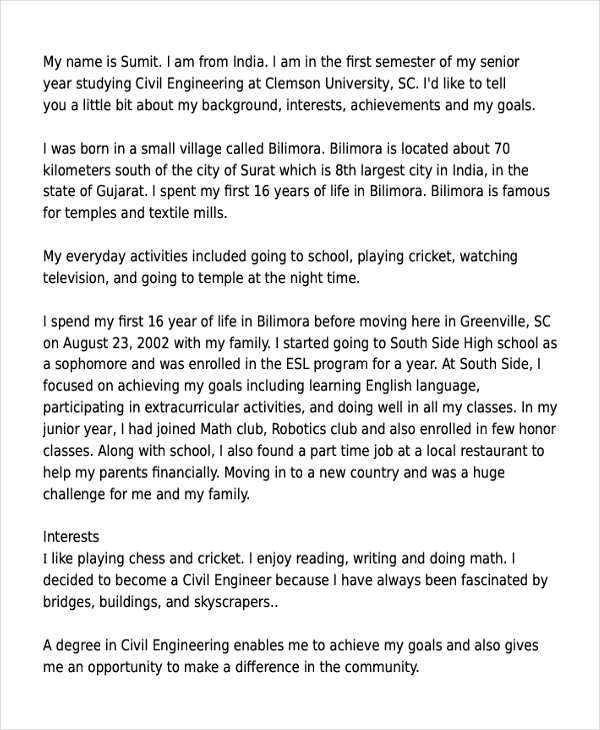
essayforum.com
Size: 14 KB
Free Attractive Introduction Essay for Interview Example
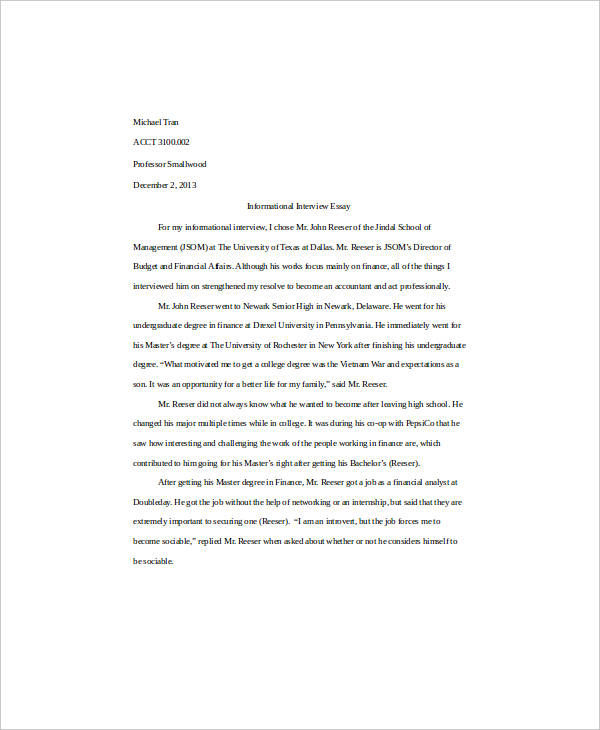
michaeltran27.weebly.com
Size: 17 KB
Formal Self Introduction Expository Example
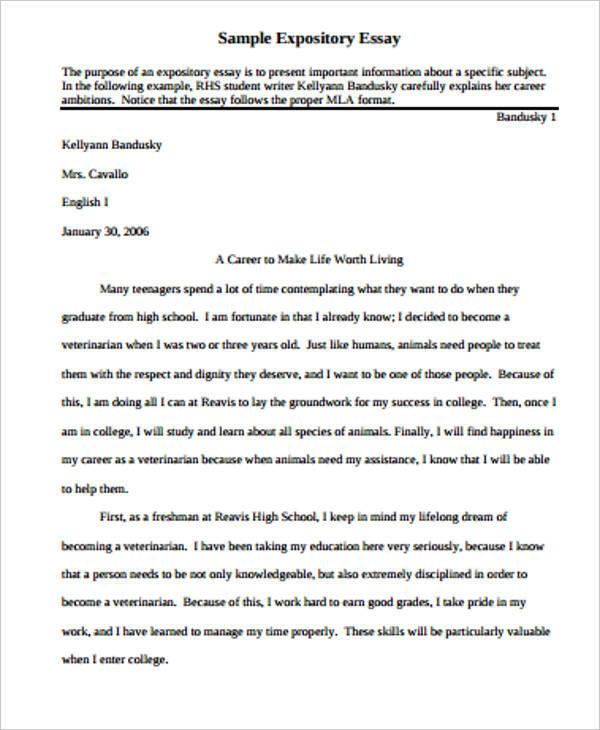
teacherweb.com
Uses of Self Introduction Essay
- College Applications : Many universities and colleges ask for a self-introduction essay as part of the application process. This essay allows admissions officers to learn more about your personality, background, and aspirations beyond your grades and test scores.
- Scholarship Applications : When applying for scholarships, a self-introduction essay can help you stand out. It’s an opportunity to share your achievements, experiences, and the reasons you deserve the scholarship.
- Job Interviews : Preparing a self-introduction essay can be useful for job interviews. It helps you articulate your professional background, skills, and career goals clearly and confidently.
- Networking : In professional networking situations, having a polished self-introduction essay can help you quickly share relevant information about yourself with potential employers, mentors, or colleagues.
- Personal Reflection : Writing a self-introduction essay is a valuable exercise in self-reflection. It can help you understand your own goals, strengths, and weaknesses better.
- Online Profiles : For personal or professional websites, social media, or portfolios, a self-introduction essay provides a comprehensive overview of who you are and what you offer, attracting potential connections or opportunities.
Tips for Writing a Self-Introduction Essay
A self-introduction essay might be one of the easiest essays to start. However, one needs to learn a few things to make the composition worth reading. You might find a lot of tips online on how to write a self-introduction essay, but here are some tips which you might find useful.
1. Think of a catchy title
The first thing that attracts readers is an interesting title, so create one.
2. Introduce yourself
You can create some guide questions to answer like: Who are you? What are your interests? What is your story? Simply talk about yourself like you’re talking to someone you just met.
3. Find a focus
Your life story is too broad, so focus on something, like: What makes you unique?
4. Avoid writing plainly
For example, instead of saying: ‘I like listening to classical music’, you can say: ‘My dad gave me an album containing classical music when I was five, and after listening to it, I was really captivated. I’ve loved it since then.’ You may also check out high school essay examples & samples
5. Simplify your work
Use simple words and language. Write clearly. Describe details vividly.
6. End it with a punch
You cannot just plainly say ‘The End’ at the last part. Create a essay conclusion which would leave an impression to your readers.
7. Edit your work
After wrapping up, take time to review and improve your work. You may also see informative essay examples & samples
What is a Creative Self Introduction Essay?
1. Choose a Theme or Metaphor:
Start with a theme or metaphor that reflects your personality or the message you want to convey. For example, you could compare your life to a book, a journey, or a puzzle.
2. Engaging Hook:
Begin with an attention-grabbing hook, such as a captivating anecdote, a thought-provoking question, a quote, or a vivid description.
3. Tell a Story:
Weave your self-introduction into a narrative or story that highlights your experiences, values, or defining moments. Storytelling makes your essay relatable and memorable.
4. Use Vivid Imagery:
Employ descriptive language and vivid imagery to paint a picture of your life and character. Help the reader visualize your journey.
5. Show, Don’t Tell:
Instead of simply listing qualities or achievements, demonstrate them through your storytelling. Show your resilience, creativity, or determination through the narrative.
6. Include Personal Anecdotes:
Share personal anecdotes that showcase your character, challenges you’ve overcome, or moments of growth.
7. Express Your Passions:
Discuss your passions, interests, hobbies, or aspirations. Explain why they are important to you and how they have influenced your life.
8. Reveal Vulnerability:
Don’t be afraid to show vulnerability or share setbacks you’ve faced. It adds depth to your story and demonstrates your resilience.
9. Highlight Achievements:
Mention significant achievements, awards, or experiences that have shaped your journey. Connect them to your personal growth and values.
10. Convey Your Personality:
Use humor, wit, or elements of your personality to make your essay unique and relatable. Let your voice shine through.
11. Share Future Aspirations:
Discuss your goals, dreams, and what you hope to achieve in the future. Explain how your experiences have prepared you for your next steps.
12. Conclude with a Message:
Wrap up your essay with a meaningful message or reflection that leaves a lasting impression on the reader.
13. Revise and Edit:
After writing your initial draft, revise and edit your essay for clarity, coherence, and conciseness. Ensure it flows smoothly.
How do you write an introduction to a self essay?
1. Start with a Hook:
Begin with an engaging hook to capture the reader’s attention. This could be a personal anecdote, a thought-provoking question, a quote, or a vivid description. The hook should relate to the essay’s theme.
2. Introduce Yourself:
After the hook, introduce yourself by stating your name and any relevant background information, such as your age, place of origin, or current location. This helps provide context.
3. Establish the Purpose:
Clearly state the purpose of your self-essay. Explain why you are writing it and what you aim to convey. Are you introducing yourself for a job application, a college admission essay, or a personal blog? Make this clear.
4. Provide a Preview:
Offer a brief preview of the main points or themes you will address in the essay. This helps set expectations for the reader and gives them an overview of what to anticipate.
5. Share Your Thesis or Central Message:
In some self-essays, especially in academic or personal development contexts, you may want to state a central message or thesis about yourself. This is the core idea you’ll explore throughout the essay.
6. Express Your Voice:
Let your unique voice and personality shine through in the introduction. Write in a way that reflects your style and character. Avoid using overly formal or stilted language if it doesn’t align with your personality.
7. Be Concise:
Keep the introduction relatively concise. It should provide an overview without delving too deeply into the details. Save the in-depth discussions for the body of the essay.
8. Revise and Edit:
After writing the introduction, review it for clarity, coherence, and conciseness. Make sure it flows smoothly and leads naturally into the main body of the essay.
Here’s an example of an introduction for a self-essay:
“Standing at the threshold of my college years, I’ve often found myself reflecting on the journey that brought me here. I am [Your Name], a [Your Age]-year-old [Your Origin or Current Location], with a passion for [Your Interests]. In this self-essay, I aim to share my experiences, values, and aspirations as I enter this new chapter of my life. Through personal anecdotes and reflections, I hope to convey the lessons I’ve learned and the person I’m becoming. My central message is that [Your Central Message or Thesis]. Join me as I explore the highs and lows of my journey and what it means to [Your Purpose or Theme].”
What is a short paragraph of self introduction
“Hello, my name is [Your Name], and I am [Your Age] years old. I grew up in [Your Hometown] and am currently studying [Your Major or Grade Level] at [Your School or University]. I have always been passionate about [Your Interests or Hobbies], and I love exploring new challenges and experiences. In my free time, I enjoy [Your Activities or Hobbies], and I’m excited to be here and share my journey with all of you.”
How do I start my self introduction?
1. Greet the Audience:
Start with a warm and friendly greeting. This sets a positive tone and makes you approachable.
Example: “Good morning/afternoon/evening!”
2. State Your Name:
Clearly and confidently state your name. This is the most basic and essential part of any self-introduction.
Example: “My name is [Your Name].”
3. Provide Additional Background Information:
Depending on the context, you may want to share additional background information. Mention where you are from, your current location, or your job title, if relevant.
Example: “I’m originally from [Your Hometown], but I currently live in [Your Current Location].”
4. Express Enthusiasm:
Express your enthusiasm or eagerness to be in the situation or context where you are introducing yourself.
Example: “I’m thrilled to be here today…”
5. State the Purpose:
Clearly state the purpose of your self-introduction. Are you introducing yourself for a job interview, a social gathering, or a specific event? Make it clear why you are introducing yourself.
Example: “…to interview for the [Job Title] position.”
6. Offer a Brief Teaser:
Give a brief teaser or hint about what you’ll be discussing. This can generate interest and set the stage for the rest of the introduction.
Example: “I’ll be sharing my experiences as a [Your Profession] and how my background aligns with the requirements of the role.”
7. Keep It Concise:
Keep your introduction concise, especially in professional settings. You can provide more details as the conversation progresses.
8. Be Confident and Maintain Eye Contact:
Deliver your introduction with confidence and maintain eye contact with the audience or the person you’re addressing.
How can I start my self introduction example?
Hi, I’m [Your Name]. It’s a pleasure to meet all of you. I come from [Your Hometown], and today, I’m excited to tell you a bit about myself. I have a background in [Your Education or Profession], and I’m here to share my experiences, skills, and passions. But before I dive into that, let me give you a glimpse into the person behind the resume. So, here’s a little about me…”
For more insights on crafting a compelling self-introduction, the University of Nevada, Reno’s Writing & Speaking Center provides valuable resources. These can enhance your essay-writing skills, especially in crafting introductions that make a lasting impression.
Self Introduction Essay Generator
Text prompt
- Instructive
- Professional
Write a Self Introduction Essay that highlights your unique qualities.
Create a Self Introduction Essay outlining your academic interests.
Self Introduction For Kids Example
Self Introduction For Freshers Example
Self Introduction For Interview Example
- Scholarships
- Certificates
- Applications
- Communication
Self Introduction for Students in English (With Examples)
A self introduction for students is a brief introduction about yourself. It is an introduction of himself to the teacher, class fellows, college, and university in which he/she is studying. The following blog post will discuss the importance of a self introduction, and we will also walk you through the process of writing a good self introduction.
What is Self Introduction?
A self introduction is a way for you to introduce yourself to others. It is a brief statement that gives an overview of who you are and what you do. Self introductions are common in many different situations, such as when starting a new job, joining a club or organization, or meeting new people in social settings.
A self introduction typically includes y our name, y our profession or field of study and a brief overview of your background and interests. It is usually just a few sentences long and is meant to give others a sense of who you are and what you do.
Self introductions are an important social skill and can help you make a good impression on others. They allow you to communicate your strengths, skills , and interests to others and can help you build connections and relationships with others. So, it is always a good idea to be prepared with a self introduction that you can use in various situations.
Self Introduction for Students
A self introduction for students is a way to introduce yourself to classmates and teachers. It is an opportunity to provide a brief overview of who you are, your background, and your interests.
As a student, your self introduction may include your name, your grade level, your school, and any extracurricular activities or interests you have. You might also mention where you are from and any other relevant information about yourself that you would like to share.
Self introductions for students are important because they help you get to know your classmates and build relationships with them. They also allow you to share your strengths and interests with others and give others a sense of who you are and what you are interested in.
Sometimes, you may be asked to give a more formal self introduction in front of the class or a group setting. In this case, it is a good idea to practice beforehand and make sure you are comfortable speaking in front of others. Overall, a self introduction for students is a great way to make a positive first impression and build connections with your peers.
Key Elements of a Self Introduction for Students
A self introduction for students should generally include the following information:
- Your name: This is the most basic and important information to include in your self introduction.
- Your age: T his is not always necessary, but it can be helpful for people to know how old you are, especially if you are introducing yourself to other students.
- Your grade level or year in school: It is important to let others know what level you are at in your education , as this can give them an idea of your knowledge and experience.
- Your interests or hobbies: It can be helpful to mention your interests or hobbies, as this can give people a sense of your personality and what you enjoy doing in your free time.
- Your goals or aspirations: It is always a good idea to let others know what you hope to achieve in the future. This can give people an idea of your motivation and ambition.
- Any relevant experience or skills : If you have any relevant experience or skills that you think would be useful to mention, it can be helpful to include them in your self introduction.
- Personal information: You may also want to include some personal information, such as where you are from, your family, and any other details that will help others get to know you better.
Remember to keep your self introduction brief and to the point. You don’t want to overload your audience with too much information, but rather give them a general overview of who you are and what you’re about.
Self Introduction Tips for Students
Self-introductions can be a useful and important way to introduce yourself to your peers, especially in a new setting or group. Here are some tips on how to prepare a self-introduction as a student:
- Start by thinking about what you want to share about yourself. Consider your hobbies, interests, and any notable accomplishments or experiences you have had.
- Practice introducing yourself out loud. This will help you feel more confident and comfortable when it comes time to actually give your self-introduction.
- Keep it brief. Self-introductions should be short and to the point, so aim for about one to two minutes in length.
- Use a clear, confident voice. Stand up straight and make eye contact with your audience to show that you are confident and engaged.
- Use a friendly and approachable tone. You want your peers to get to know you and feel comfortable interacting with you, so be sure to come across as friendly and approachable.
- Be yourself. Don’t try to be someone you’re not or present a false image of yourself. Be genuine and authentic, and your peers will appreciate it.
- Consider including a personal anecdote or story. This can help make your self-introduction more memorable and engaging.
The key to a successful self-introduction is to be confident, concise, and authentic. By following these tips, you can effectively introduce yourself to your peers and make a positive impression.
Importance of Self Introduction for Students
Self introductions are important for students because they help you get to know your classmates and build relationships with them. Here are some of the reasons why self introductions are important for students:
- First impressions: Self introductions allow you to make a good first impression on your classmates and teachers. By introducing yourself in a confident and friendly manner, you can show others that you are a likable and trustworthy person.
- Building relationships: Self introductions allow you to build relationships with your classmates by sharing information about yourself and learning about them. This can help you connect with others and create lasting relationships.
- Confidence: Self introductions can help boost your confidence by allowing you to practice speaking in front of others and highlighting your strengths and skills.
- Teamwork: In group projects or activities, self introductions can help you get to know your team members and establish a sense of trust and respect within the group.
- Personal branding: Self introductions allow you to communicate your values, interests, and goals to others, which can help you build your personal brand as a student. This can be particularly important if you want to get involved in extracurricular activities or consider applying to college or university.
Self introductions are an important social skill for students because they help you build relationships, boost your confidence, and establish your personal brand. So, it is always a good idea for students to be prepared with a self introduction that they can use in various situations.
Self Introduction in English for Students
Here are some self introduction speech examples for students in English.
My Self Introduction in English
Hello everyone,
My name is Rohit, and I am from New Delhi. I am currently pursuing a degree in business management and have always been interested in finance and economics. In my free time, I enjoy reading business books and keeping up with the latest news and trends in the industry. I am also an avid traveler and love to visit new places and learn about different cultures.
I believe that traveling helps broaden one’s perspective and helps one understand the world better. I am a hardworking and dedicated individual and always strive to give my best in everything I do. I am looking forward to a great academic journey at this university and hope to make the most of the opportunities that come my way.
I hope to make meaningful contributions to the field of business management and help make a positive impact in the world.
Simple Self Introduction for Students
Hi everyone,
My name is [Name], and I am a [grade level] student at [school name]. I am [age] years old, and I come from [city/country]. Some of my interests include [list hobbies or interests]. In the future, I hope to study [field of study] and become a [career goal].
It’s great to be a part of this class, and I’m looking forward to getting to know all of you.
Self Introduction for Students in School
Here are examples of a self-introduction for students in school:
Hello everyone, my name is ___________, and I am a student at ___________. I am originally from ___________ and have been living in ___________ for ___________ years. In my free time, I enjoy ___________ and ___________. My academic interests lie in ___________ and ___________, and I hope to pursue a career in ___________ in the future. I am excited to be a part of this ___________ and am looking forward to making new friends and learning new things. Thank you.
I am a student of Class X. I am in a boarding school in Kota. I live in the village of Chittorgarh, Rajasthan. I am a student of 10th standard. I have a father whose name is Ramesh. My mother is a housewife.
Now I am a student of class x. My hobby is watching movies. I am a good boy. I live in the hostel. I like to read books.
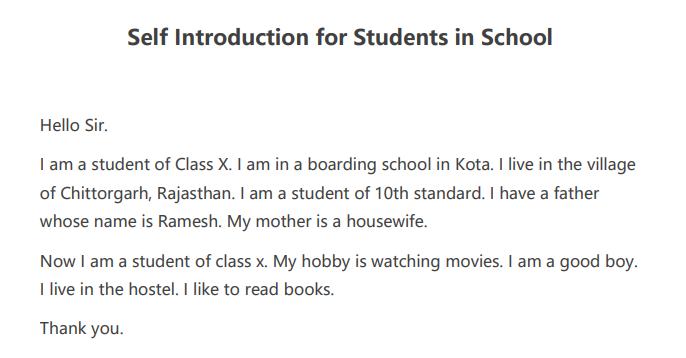
Hello, my name is ______. I am a student at _______. I am from _____. I am studying _______. I am interested in ________. I am a member of ________. I am also involved in ___________.
I am a very outgoing person, and I love to meet new people. I am looking forward to meeting all of you and getting to know you better.
Thank you for having me here today.
Self Introduction in English for College Students
Hello, everyone!
My name is ____and I’m a college student at _____. I’m originally from ____ and I’m majoring in _____.
I’m really passionate about ______and I hope to pursue a career in that field after graduation. In my free time, I enjoy _____, ____, and _____.
I’m really looking forward to getting to know everyone in this class, and I hope we can all become friends!.
Thanks for letting me introduce myself!
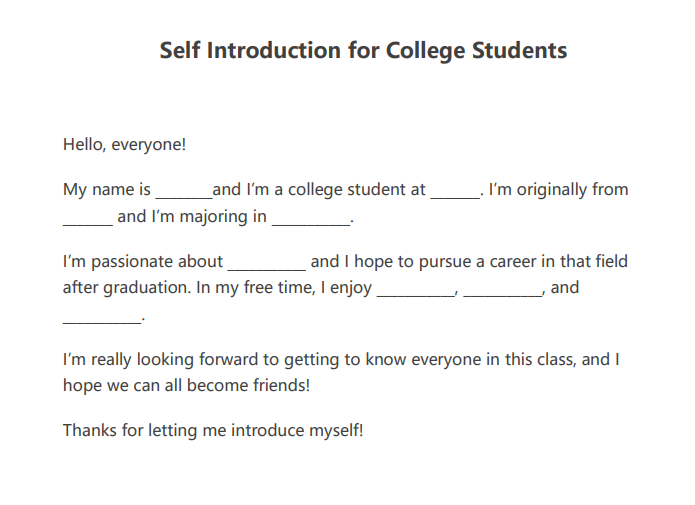
My name is ___ and I am a college student at ____. I am originally from ___, but I have been living in the United States for the past ___ years. I am majoring in ____ and I hope to someday work in the ___ field.
I am a very outgoing person, and I love meeting new people. I am also very involved on campus, and I am a member of ___. In my free time, I enjoy ___. I am a very friendly person, and I am always willing to help others.
I am really looking forward to meeting all of you and getting to know you better!
Hello everyone,
My name is ____, and I am a [year in college] student at [college name]. I am originally from [city/country] and have always been passionate about [list interests or hobbies]. In college, I am majoring in [major], and I hope to use my degree to pursue a career in [career goal].
I am a hardworking and dedicated student who is always eager to learn and take on new challenges. In my free time, I enjoy [list hobbies or interests] and am involved in [list extracurricular activities or clubs].
I am excited to be a part of this community , and I look forward to meeting and learning from my fellow students.
Self Introduction for Freshers in College
My name is Rohit, and I am a fresher in college. I am from Gujarat and have always been passionate about learning new things. I decided to pursue a degree in business management because I believe that it is a field that can open up numerous opportunities for personal and professional growth.
In my free time, I enjoy playing sports and listening to music. I am also an avid reader and enjoy reading books on economics and finance. I am excited to be a part of this college and am looking forward to making new friends and learning from my professors.
I hope to make the most of my college time and become a well-rounded and successful individual.
My name is Priya, and I am a fresher in college. I am originally from Chennai and have always been passionate about education and learning new things. I chose to pursue a degree in commerce because I believe that it is a field that is constantly evolving and provides a wealth of opportunities for growth and advancement.
In my free time, I enjoy reading books, listening to music, and spending time with my friends and family. I am excited to be a part of this college and am looking forward to meeting new people and learning from my professors.
I hope to make the most of this opportunity and achieve my academic and professional goals.
Self Introduction for Engineering Students Freshers
My name is Siddharth, and I am a fresher engineering student. I hail from Kolkata and have always been passionate about science and technology. I chose to pursue a career in engineering because I believe that it is a field that has the potential to make a real difference in the world.
I am particularly interested in computer science and hope to one day work on cutting-edge technology that can help solve some of the world’s most pressing problems. In my free time, I enjoy playing chess and reading books on science and mathematics. I am excited to be a part of this university and am looking forward to learning from my professors and fellow students.
I hope to positively contribute to the field of engineering and make a meaningful impact in the world.
Self Introduction for Students in Interview
My name is Priya, and I am a student currently pursuing my degree in Business Management. I am from Hyderabad and have always been interested in finance and economics. I believe that a career in business management can provide me with the opportunity to not only grow personally and professionally but also make a positive impact in the world.
In addition to my academic pursuits, I am also a member of my school’s debate team and have participated in numerous competitions. Outside of school, I enjoy spending time with my friends and family, and I also love to travel and explore new places.
I am confident that my skills and dedication will make me a valuable asset to any organization, and I am eager to learn and grow in my career. Thank you for considering me for this opportunity.
Self-introduction Sample for Job Interview Fresher
My name is Manav, and I am a recent graduate from XYZ University. I studied Computer Science and have always been interested in technology and programming. During my time in the university, I gained practical experience through internships at companies such as ABC and DEF. These experiences helped me develop problem-solving, communication, and teamwork skills.
I am excited to apply for this role as a Software Developer at your company. I believe that my education and experience make me a strong fit for this position, and I am confident that I can contribute to the success of the team. I am eager to learn and grow as a professional, and I believe that this role would provide me with a great opportunity to do so.
In my free time, I enjoy staying up to date with the latest technological advancements and also love to play video games and watch movies. I am a detail-oriented and dedicated individual, and I am committed to delivering high-quality work.
I hope to have the opportunity to contribute to your company and make a positive impact. Thank you for considering me for this role.
Self Introduction Example for Students ( Self Introduction Sample)
Self-introduction in english for school students example.
My name is Rohan, and I am a student in grade 9. I am originally from Delhi and have been living in Mumbai for the past 5 years. In my free time, I enjoy playing football and reading books. I am also a member of my school’s debating team and have participated in numerous competitions. My academic interests lie in math and science, and I hope to pursue a career in engineering in the future.
I am excited to be a part of this school and am looking forward to making new friends and learning new things.
My name is Arjun, and I am a student in grade 7. I am from Bangalore and have been living here my whole life. In school, I am a part of the basketball team and also enjoy playing the guitar. My favorite subjects are history and English, and I am particularly interested in learning about different cultures and civilizations. Outside of school, I enjoy spending time with my family and friends, and I also love going on bike rides.
I am looking forward to a great year at this school and hope to make the most of the opportunities that come my way.
Self-introduction in English for College Students Example
My name is Vikram, and I am a second-year student at XYZ College. I hail from New Delhi and completed my high school from DEF School. I am currently studying Computer Science and am very interested in exploring the field of Artificial Intelligence and Machine Learning. Outside of academics, I am an avid chess player and have won several tournaments at both the school and college level. I am also a member of the college’s debate team and have participated in numerous debates and competitions. In my spare time, I enjoy playing the guitar and listening to music.
I am excited to be a part of this diverse and talented community at XYZ College.
My name is Sanjay, and I am a junior at XYZ College. I am from Bangalore and have completed my high school from GHI School. I am currently pursuing a degree in Business Management and have always been interested in entrepreneurship and start-ups. I have interned at several well-known companies in the past and hope to gain valuable experience and insights during my time at college.
Apart from academics, I am also involved in several extracurricular activities, such as singing and dancing. I have been a part of the college’s music and dance club for the past two years and have participated in various inter-college festivals. In my free time, I enjoy traveling and trying new cuisines.
I am looking forward to the rest of my college journey and all the opportunities it brings.
How to Give an Introduction in English?
To give an introduction in English, you can follow these steps:
- Start by stating your name and your role or position. For example, “Hi, my name is Sarah and I am a student at XYZ University.”
- Provide some background information about yourself, such as where you are from and any relevant experiences or interests.
- Share your goals or aspirations for the future. This could be related to your studies or career goals.
- Conclude your introduction by thanking the audience for their time and attention.
Some tips for giving an effective introduction in English include:
- Speak clearly and enunciate your words
- Use confident body language
- Keep it brief and to the point
- Use appropriate language and tone based on the context and audience
- Practice beforehand to feel more comfortable and confident.
We hope you enjoyed our blog post on self introduction for students. Whether you’re a student in high school, college, or a professional in the workplace, it can be challenging to know how to introduce yourself to others.
We hope you can use what you learned here to help make your introduction more meaningful and memorable! Thanks for reading . If you have any other questions, please write in the comment box!
Shobhit is the founder of Ishiksha, content writer and educator who has been creating educational content since 2021. His writing covers topics like science, technology, and the humanities. When he isn't writing, Shobhit enjoys reading nonfiction, watching documentaries, and going on nature walks.
Save my name, email, and website in this browser for the next time I comment.
Type above and press Enter to search. Press Esc to cancel.
Have a language expert improve your writing
Check your paper for plagiarism in 10 minutes, generate your apa citations for free.
- Knowledge Base
- College essay
How to Write a Great College Essay Introduction | Examples
Published on October 4, 2021 by Meredith Testa . Revised on August 14, 2023 by Kirsten Courault.
Admissions officers read thousands of essays each application season, and they may devote as little as five minutes to reviewing a student’s entire application. That means it’s critical to have a well-structured essay with a compelling introduction. As you write and revise your essay , look for opportunities to make your introduction more engaging.
There’s one golden rule for a great introduction: don’t give too much away . Your reader shouldn’t be able to guess the entire trajectory of the essay after reading the first sentence. A striking or unexpected opening captures the reader’s attention, raises questions, and makes them want to keep reading to the end .
Table of contents
Start with a surprise, start with a vivid, specific image, avoid clichés, other interesting articles, frequently asked questions about college application essays.
A great introduction often has an element of mystery. Consider the following opening statement.
This opener is unexpected, even bizarre—what could this student be getting at? How can you be bad at breathing?
The student goes on to describe her experience with asthma and how it has affected her life. It’s not a strange topic, but the introduction is certainly intriguing. This sentence keeps the admissions officer reading, giving the student more of an opportunity to keep their attention and make her point.
In a sea of essays with standard openings such as “One life-changing experience for me was …” or “I overcame an obstacle when …,” this introduction stands out. The student could have used either of those more generic introductions, but neither would have been as successful.
This type of introduction is a true “hook”—it’s highly attention-grabbing, and the reader has to keep reading to understand.
Prevent plagiarism. Run a free check.
If your topic doesn’t lend itself to such a surprising opener, you can also start with a vivid, specific description.
Many essays focus on a particular experience, and describing one moment from that experience can draw the reader in. You could focus on small details of what you could see and feel, or drop the reader right into the middle of the story with dialogue or action.
Some students choose to write more broadly about themselves and use some sort of object or metaphor as the focus. If that’s the type of essay you’d like to write, you can describe that object in vivid detail, encouraging the reader to imagine it.
Cliché essay introductions express ideas that are stereotypical or generally thought of as conventional wisdom. Ideas like “My family made me who I am today” or “I accomplished my goals through hard work and determination” may genuinely reflect your life experience, but they aren’t unique or particularly insightful.
Unoriginal essay introductions are easily forgotten and don’t demonstrate a high level of creative thinking. A college essay is intended to give insight into the personality and background of an applicant, so a standard, one-size-fits-all introduction may lead admissions officers to think they are dealing with a standard, unremarkable applicant.
Quotes can often fall into the category of cliché essay openers. There are some circumstances in which using a quote might make sense—for example, you could quote an important piece of advice or insight from someone important in your life. But for most essays, quotes aren’t necessary, and they may make your essay seem uninspired.
If you want to know more about academic writing , effective communication , or parts of speech , make sure to check out some of our other articles with explanations and examples.
Academic writing
- Writing process
- Transition words
- Passive voice
- Paraphrasing
Communication
- How to end an email
- Ms, mrs, miss
- How to start an email
- I hope this email finds you well
- Hope you are doing well
Parts of speech
- Personal pronouns
- Conjunctions
The introduction of your college essay is the first thing admissions officers will read and therefore your most important opportunity to stand out. An excellent introduction will keep admissions officers reading, allowing you to tell them what you want them to know.
The key to a strong college essay introduction is not to give too much away. Try to start with a surprising statement or image that raises questions and compels the reader to find out more.
Cliché openers in a college essay introduction are usually general and applicable to many students and situations. Most successful introductions are specific: they only work for the unique essay that follows.
In most cases, quoting other people isn’t a good way to start your college essay . Admissions officers want to hear your thoughts about yourself, and quotes often don’t achieve that. Unless a quote truly adds something important to your essay that it otherwise wouldn’t have, you probably shouldn’t include it.
Cite this Scribbr article
If you want to cite this source, you can copy and paste the citation or click the “Cite this Scribbr article” button to automatically add the citation to our free Citation Generator.
Testa, M. (2023, August 14). How to Write a Great College Essay Introduction | Examples. Scribbr. Retrieved April 8, 2024, from https://www.scribbr.com/college-essay/introduction-college-essay/
Is this article helpful?

Meredith Testa
Other students also liked, college essay format & structure | example outlines, how to end a college admissions essay | 4 winning strategies, what do colleges look for in an essay | examples & tips, "i thought ai proofreading was useless but..".
I've been using Scribbr for years now and I know it's a service that won't disappoint. It does a good job spotting mistakes”
404 Not found
How to Introduce Yourself in College (as a Student)
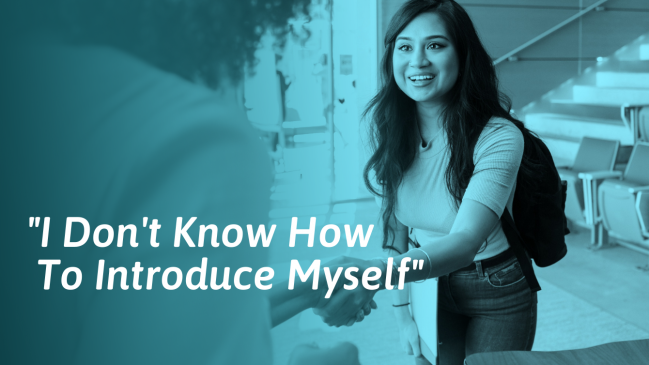
Starting college can be exciting, overwhelming—and scary. Meeting and getting to know new people on campus is one of the best ways to feel more comfortable and at ease from the first day. People who make new friends in college report having an easier time adjusting to campus life and are also more likely to still be around in their second year. [ 1 , 2 ]
Whether you are moving into a dorm, commuting to college, or taking online classes, this article can help you figure out how to introduce yourself to people in college and become part of the social scene on campus.
1. Assume you’re not the only new student
Your first day of classes can feel a lot like being the “new kid” in school who doesn’t know how to get to their homeroom class or who to sit with at lunch. It can be daunting when you don’t know anyone in your new school, but most people you meet on your first day are also new students. This means that most will be just as eager (and nervous) to meet new people as you are, which makes it easier to figure out how to approach people and make friends .
2. Craft an intro speech
Because there’s a good chance that you will get asked to introduce yourself many times in your first days in college—for example, in some of your classes—you may want to craft a brief introduction speech.
Good intros provide basic information about who you are, where you are from, and what your goals are for college, as well as providing an interesting detail or two that people can remember you by.
Here is an example of a good intro to use when first meeting other students or professors:
“Hi, my name is Carrie, and I’m originally from Wisconsin. I’m a military kid, so I’ve lived all over the US and Europe. I’m hoping to major in finance and also to study abroad.”
Practicing some words to say in specific situations can be particularly useful for transfer students. If you are one of them, take a look at this article on how to make friends as a transfer student .
3. Make a positive, intentional impression
People form first impressions of others within seconds of meeting them, with or without their knowledge. Being intentional about the impression you make helps you take advantage of these first opportunities to meet people at college.
Here are some tips on how to start a self-introduction:
- Intention : Your “goal;” what you hope to achieve by introducing yourself.
Example: Set yourself the goal of sharing more about your major (e.g., “I’m majoring in finance and would love to meet others in my department!”).
- Impression : Something you want others to remember about you.
Example: Consider making a memorable impression by sharing something interesting about yourself (e.g., “A fun fact about me is that I’m fluent in Russian”).
- Inside information : “Inside information” is what you want others to know about you.
It should give others important clues to who you are and what you are looking for in your college experience. Example: “I am from Hawaii, so this is my first time on the mainland and it’s really different! I’m still adjusting to the weather.”
4. Initiate 1:1 conversations
It can be overwhelming to introduce yourself to a class or large group of people, and it can also be difficult to form personal connections this way. Try to approach people who seem like they have things in common with you, as friendships are more likely to develop among people who are similar to each other. [ 5 ] Start by walking up, saying hello, and introducing yourself. If they seem open to talking, you can also start a more in-depth conversation by asking them questions about where they are from or how they are settling in.
5. Connect with suitemates before school starts
Being on-campus gives you a big advantage because it makes it easier to adjust and adapt to college life and also provides more natural opportunities to meet people and make friends. [ 4 ]
If you are moving into on-campus housing, consider reaching out to your suitemates before school starts by searching for them on social media or using contact information provided to you by the college.
This way, you can both go to college knowing at least one other person, which can make the first days easier. Also, connecting on social media ahead of time has been proven to make your first interactions with housemates less awkward. [ 2 ]
6. Learn people’s names
Make a point to remember the names of people you meet and talk to, and try to use their names aloud in a conversation with them. This simple trick is a proven way to help you remember names and also helps you make a positive impression on people. [ 6 ] When you know their name, it’s also easier to say hello or start conversations with them when you see them in class or around campus.
7. Talk about common struggles
Inconveniences are a part of the adjustment process to college life but also provide opportunities to naturally connect and relate to people. For example, saying, “I’ve been there!” to someone who looks lost on campus, is rushing to class, or just got a parking ticket can be a great “in” to introduce yourself. By being observant of other people, you can often find opportunities to use this approach and even offer a helping hand to someone.
8. Be active in your classes
Being active in your classes is one of the best ways to get to know your classmates while also getting to know your professors. Speaking up and sharing your input and opinions in class will help your classmates get to know you while also helping you form a good relationship with instructors. Good relationships with your professors can help open doors in your academic and professional life, as well as helping you adjust to college. [ 3 ]
9. Develop an on-campus social media presence
Research has shown that connecting with new college friends on social media can help new students build a new social life. Students who are socially connected with other students also have an easier time transitioning to college and are also more likely to still be enrolled in college the next year. [ 1 , 2 ]
You can work on building your social media presence at college by:
- Cleaning up your social media profiles by making sure pictures and posts are up-to-date and reflect the content you want others to see.
- Join social media groups with other students at your college.
- Stay up-to-date on current events and activities on campus by subscribing for updates or following university social media accounts.
- Connect 1:1 with classmates, friends, and people at your dorm on social media to message and connect directly with them.
10. Get involved in your college’s social scene
If you stay cooped up in your dorm and only come out for classes and bathroom breaks, you will have a hard time adjusting to college life. Going to on-campus events is a proven way to help students adjust, adapt, and develop an active social life in college. [ 3 , 7 ]
There are many ways to get more active and involved in on-campus activities, including:
- Consider the Greek life : Research different sororities and fraternities at your school, and consider attending a recruitment event.
- Attend campus events and socials : Attend events and socials on campus to meet new people and get oriented to campus life.
- Join a club, sport, or activity : If you have a hobby or interest, consider joining an existing club, sport, or activity at your school to meet people with similar interests.
11. Invite people out
Asking people to hang out can be difficult and intimidating but gets easier with practice. The key is to keep the invitation casual by saying something like, “Here’s my number. We should study together sometime” or, “I was thinking of going for coffee later if you feel like joining?” By taking this first step, you are showing interest in people, being friendly, and creating a chance to connect with them more personally.
12. Ask good questions
When people are nervous, they often ramble or talk too much about themselves, but one of the best ways to make conversation is to ask good questions. Asking questions is a great way to show interest in other people, which is proven to make you more likable. [ 6 ] Asking questions can also be a great way to keep a conversation going or to go deeper in a conversation and find things in common with someone .
Here are some questions to introduce yourself and find things in common with people:
- “What did you think about class today?”
- “Where are you from originally?”
- “What are you majoring in?”
- “How are you adjusting?”
- “What kinds of things do you like doing outside of class?”
13. Hone your online introduction
If you are in an online class, it’s a good idea to customize your profile in ways that help your professor and classmates get to know you. Add a photo and brief message to your profile for online classes. Also, introduce yourself to individual classmates by responding directly to their posts, messages, or online introductions. This can provide them with some validation while also giving you an easy ‘in’ to start future conversations with them.
14. Get people to come to you
You don’t have to do all of the work to introduce yourself and start conversations with people, especially if you know how to get people to come to you. According to research, being friendly, showing interest in others, and giving people your undivided attention go a long way towards making a good impression. [ 6 ] Being open and participating in classes also helps to attract people to you who share similar interests, ideas, and goals.
You can create easy opportunities for people to approach you by:
- Coming to class a few minutes early or taking your time leaving
- Studying in public areas of campus
- Attending more on-campus events
- Responding to comments of other students in classes
- Talking about your interests and opinions in classes
15. Develop an inside-out approach
People will feel more comfortable talking to you and can relate to you better when you take an ‘inside-out’ approach, letting more of your true thoughts, feelings, and personality show. [ 6 ] Often, being nervous causes people to hide their true self or put on a front or persona, but being more authentic is proven to lead to more genuine and meaningful interactions. [ 8 ]
Final thoughts
- Gray, R., Vitak, J., Easton, E. W., & Ellison, N. B. (2013). Examining social adjustment to college in the age of social media: Factors influencing successful transitions and persistence. Computers & Education , 67 , 193-207.
- Yang, C. C., & Lee, Y. (2020). Interactants and activities on Facebook, Instagram, and Twitter: Associations between social media use and social adjustment to college. Applied Developmental Science , 24 (1), 62-78.
- Terenzini, P. T., Rendon, L. I., Upcraft, M. L., Millar, S. B., Allison, K. W., Gregg, P. L., & Jalomo, R. (1994). The transition to college: Diverse students, diverse stories. Research in higher education , 35 (1), 57-73.
- Buote, V. M., Pancer, S. M., Pratt, M. W., Adams, G., Birnie-Lefcovitch, S., Polivy, J., & Wintre, M. G. (2007). The Importance of Friends: Friendship and Adjustment Among 1st-Year University Students . Journal of Adolescent Research, 22 (6), 665–689.
- Van Duijn, M. A., Zeggelink, E. P., Huisman, M., Stokman, F. N., & Wasseur, F. W. (2003). Evolution of sociology freshmen into a friendship network. Journal of Mathematical Sociology , 27 (2-3), 153-191.
- Bradberry, T. (2017). 13 habits of exceptionally likable people . HuffPost .
- Bohnert, A. M., Aikins, J. W., & Edidin, J. (2007). The Role of Organized Activities in Facilitating Social Adaptation Across the Transition to College . Journal of Adolescent Research, 22 (2), 189–208.
- Rodebaugh, T. L. (2009). Hiding the self and social anxiety: The core extrusion schema measure. Cognitive Therapy and Research , 33 (1), 90.
Hailey Shafir is a licensed mental health counselor, licensed addiction specialist, and clinical supervisor working out of Raleigh, NC. She has a Masters in Counseling from NC State University, and has extensive professional experience in counseling, program development, and clinical supervision. Read more .

“I Have No Personality” – Reasons Why and What to Do

120 Charisma Quotes to Inspire You and Influence Others

How To Be More Charismatic (And Become Naturally Magnetic)

12 Qualities That Make a Person Interesting

How To Be More Authentic And Genuine

How to Stand Out and be Memorable in Any Social Situation
Leave a comment cancel reply.
Notify me when someone responds to my comment.
To get advice relevant to you, choose below:
What is your relationship status, how would you describe your social skills, what statement best describes you, how motivated are you to deepen your friendships, how motivated are you to find like-minded friends, do you agree with this statement “i want to be more likable”, do you agree with this statement “i want to be more interesting to talk to”, do you agree with this statement “i want to be less awkward”, what best describes you, responses successfully analyzed, where should we send your personalized tips.
Self Introduction Essay
500 words essay on self introduction.
Writing about oneself is not a very difficult task. One of the reasons for this is that no one knows better about you than your own self. Keeping this in mind, let us explore more on this topic with this self introduction essay.

Self Introduction Essay
Understanding Oneself
An important point to remember writing about self-introduction is that every individual is different. So, when one writes about oneself, it is actually about showing one’s uniqueness. Furthermore, your self-introduction shows how well you know about yourself.
Self-introduction is a way of coming up with things you know about yourself. Furthermore, everyone around a person has different things to say about that person. Moreover, the person’s own personal perception may or may not match with the opinion of others.
When one begins to write, a small introduction is a good way of briefly explaining who the person is and what the profession of this individual is. Afterwards, one can write about one’s hobbies and talents. Moreover, if there is a desire to go into more details, then one can explain how these hobbies were acquired.
One advantage of writing about self-introduction is that one would be able to know oneself better. Among billions of people on Earth, you are the most suitable person to tell what’s best for you. Thinking this way, one would not lose any interest during the self-introduction writing.
Each person has a different mission in life and a different journey to follow. Therefore, writing about the self-introduction, an individual must explain oneself with honesty , without deviating from the truth. Most noteworthy, honestly revealing such information would build up self confidence .
Get the huge list of more than 500 Essay Topics and Ideas
Interests and Inspirations
Each person on this planet has different interests and hobbies. Furthermore, people derive happiness and satisfaction from doing different things. While cooking gives comfort to some, others find pleasure in reading books.
Due to self-introduction, one would be able to better understand all the various hobbies and find out which of them suits the person most. For example, a man may go through all his interests and ultimately discover the hobby that provides him with maximum satisfaction. As such, self-introduction may give rise to the process of self-introspection.
Dreams, ambition , and aspirations are also very important parts of self-introduction. While many people have dreams of acquiring success in the field of science, others may have more interest in sports. It all comes down to the attitude and personality of a person.
So think hard about what you want to become in life and make sure to mention it in the self-introduction. Psychologically speaking, what one mentions in the self-introduction can remain in that individual’s sub-conscious. Most noteworthy, the person may ultimately start living his dream.
Conclusion of Self Introduction Essay
The self introduction essay shows that each individual is different from one another. Furthermore, each person has got a set of personal ideas, tastes, hobbies, passions, behaviours, and inspirations that is not shared by others. As such, self-introduction is a way of showing the unique side of each individual.
FAQs For Self Introduction Essay
Question 1: What is the importance of self-introduction?
Answer 1: The importance of self-introduction is that it brings out the uniqueness of each individual. This is because each individual is different and no two individuals can be alike. Moreover, it is a way of showing people what one knows about oneself.
Question 2: What are some aspects of one’s personality that can be revealed during self-introduction?
Answer 2: The aspects of one’s personality that can be revealed during self-introduction are interests, hobbies, ambitions, and aspirations.

Customize your course in 30 seconds
Which class are you in.

- Travelling Essay
- Picnic Essay
- Our Country Essay
- My Parents Essay
- Essay on Favourite Personality
- Essay on Memorable Day of My Life
- Essay on Knowledge is Power
- Essay on Gurpurab
- Essay on My Favourite Season
- Essay on Types of Sports
Leave a Reply Cancel reply
Your email address will not be published. Required fields are marked *
Download the App

- Self Introduction
- Start Conversation
- Self Introduction Generator
- Introduction in Other Languages

How To Introduce Yourself In College Class?( With 5+ Examples)
Beginning college is one of the most exciting but daunting times in your life. You’re going to come into a whole new environment, where you’re surrounded by people your age and many new things. To make your transition as easy as possible, you want to make as many friends as possible and to do that, you have to have self-confidence.
That’s why we’re going to help you with how to introduce yourself in college class example and show you some of the best ways to meet new people and make friends in the first few weeks of college.
How To Introduce Yourself In College Class Example?
I’m [name], and I’m a first-year student at [college name]. When you ask me how I like it here, I’ll tell you that it’s different than anything else I’ve ever been to—and that’s not just because of the size.
I’ve always been interested in learning about the world and its cultures. Still, my parents are from Brazil, so much of my education has been through traveling there. The last time I was at school, I had come from a place where everyone spoke English as their primary language. Every class is taught in Spanish, which is cool because it forces me to learn a new language! But it also makes me feel more connected with what’s happening around me and helps me understand how people think and act.
I’m looking forward to joining the [club name] team this year because we’re doing some fun things together, like going on field trips!
At the beginning of class, I would like to introduce myself. I am [name], and I am a first-year student. My major is [major]. I will take courses in [course 1] and [course 2].
I would also like to thank my advisor for helping me get into college and being such a great role model!
Hi, I’m [name], a first-year transfer student. I’m from [city], but I’ve lived in [country] my whole life. My parents are both doctors and were so excited to get me into this program because they knew how much I wanted to go to college!
I enjoy learning about different cultures and languages, so I’m excited to see what’s waiting for me at [college].
Introduce Yourself To Class Example
I’m [name], a first-year student at [university name].
I’m excited to be here, and it’s going to be great! I love studying, and I want to learn more about the subject we’re going to study this semester.
I’ve been interested in [subject] since high school—it’s one of my favourite subjects. One of the reasons I love it so much is because it helps me learn how to problem-solve and think outside the box. It also teaches me how to communicate effectively with others, which is essential in life!
Hi! I’m [name]. I’m a recent graduate of [university] with a degree in [subject].
I’ve worked at [company] for the past five years and love it, mainly because of the people. I feel like I have found my place here and am so excited for this new chapter in my life.
My favourite thing about working here is seeing the big picture, which is why I am so excited to work on projects that will help me get there. The first project that comes to mind is one we are working on now called “Project X.” It’s an immersive narrative experience that takes place inside an abandoned building in downtown Chicago. The goal is to make people feel like they are part of the story, which has been challenging because of how many moving parts there are.
We are currently looking for someone who can help us with this project by doing things like programming code or designing graphics—someone who has experience with either thing would be amazing!
- 6+ Examples of Self Introduction Sample For Portfolio
- 7+ Samples of Self Introduction In Software Company Interview
Hi, I’m [name], a junior at U.I.C.
I’m in the class of 2021, and I’m a double-major in accounting and finance. I also have a minor in economics.
I’ve been working as an accountant for a few years now and enjoy it because it helps me to understand how businesses work and how money flows through them.
My favorite part about accounting is that you use numbers all day long, which keeps things interesting!
Tips For Introducing Yourself To Class In College
1. Have a strong opening line.
2. Keep it short and straightforward.
3. Include your hobbies.
4. Tell them what you do to stay motivated in life.
5. Don’t forget to mention your goals and aspirations.
6. Talk about what you are passionate about.
7. Include a memorable quote of yours.
8. Mention Your Favourite Books/Authors/Songs/Movies/TV Shows
Takeaway: A good introduction is memorable, exciting, and leaves an impression on the listener. So, when introducing yourself in a college class, follow these tips, and you can make a place for yourself in the hearts of classmates and teachers alike.
The Verdict: How To Introduce Yourself In College Class Example?
We hope you enjoyed our article about how to introduce yourself in college. With this knowledge, we are sure that you will be able to make a great impression on your peers during your first day of class and beyond. Best of luck in your next semester of college, and if you need any help making new friends, please don’t hesitate to contact us.
Hi, I a Usmaan Ali, a content writer. I’ve always been passionate about writing and blogging. I hope you enjoy my blog posts as much as I enjoy writing it!
Related Posts
5+ examples of business self introduction email, self introduction in interview for experienced candidates, self introduction for medical representative interview, leave a reply cancel reply.
Save my name, email, and website in this browser for the next time I comment.
Type above and press Enter to search. Press Esc to cancel.
- Top Colleges
- Top Courses
- Entrance Exams
- Admission 2024
- Study Abroad
- Study in Canada
- Study in UK
- Study in USA
- Study in Australia
- Study in Germany
- IELTS Material
- Scholarships
- Sarkari Exam
- Visual Stories
- Write a review
- Login/ Register
- Login / Register
Self Introduction for Students: Examples, Tips, Things to Avoid

Pallavi Pradeep Purbey ,
Mar 11, 2024
Share it on:
A self introduction for students is a concise, assured, and straightforward introduction. It should describe the student's personality, identity, and what details other people should be aware of.
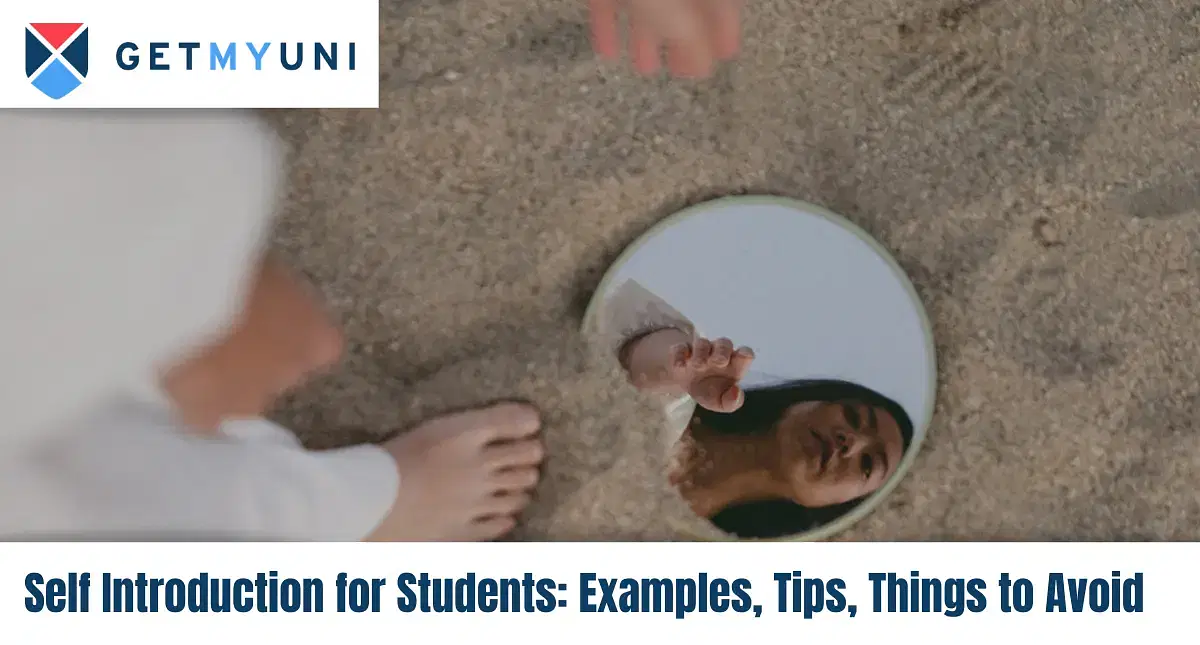
A self-introduction is a brief statement or remark that a person gives to others to introduce themselves. It allows them to provide vital details about themselves, such as their name, background, hobbies, and objectives.
It ought to explain the student's identity, and personality, and what attributes of the students should be known to the audience. A student's self introduction includes the name and essential details about them.
Besides, they also include facts creating an ideal impression of the person. A good self introduction for students will help them get new acquaintances and network with more people.
Table of Contents
- Examples of Self Introduction for Students
Steps to Draft a Good Self Introduction for Students
- Key Elements of Self Introduction for Students
- Important Tips for Self Introduction for Students
What is Self Introduction?
Importance of self introduction for students.
- Things to Avoid During Self Introduction for Students
- How to Practice Self Introduction?
- Books for Enhanced English
Examples of Self Introduction for Students
Self Introduction is essential to have clear communication. The students should be able to communicate freely and make an effort to address the audience smartly. Below are the best self introduction example for students.
- Example 1: Self Introduction for students during a college interview
- Example 2: Self Introduction for students to a team
- Example 3: Classroom Self Introduction for students
Example 1: Self Introduction for Students during a College interview
Good morning Sir/Ma'am,
I am Amogh, born and brought up in Bandra. Thank you for allowing me to introduce myself. I scored 77% in my school at Little Flowers Montessori English Medium High School. I scored 77.7% at SSWN Junior College.
I believe my strength is my attitude, and I like to take up challenges and think to accept both success and failure in a balanced way to move forward. I want to say that I don't leave any questions altogether as I believe in myself and my work.
My short-term goal is to find my area of interest in various clubs that the college organized. And my long-term goal is to get placed in a high-paying position and a holistic work environment that allows me to learn and implement my ideas. That's all about me, sir.
Thank you for providing me with such an excellent opportunity to introduce myself.

Also Check : 10 Prioritization Techniques for Student Productivity
Example 2: Self Introduction for Students to a Team
Good morning Ma'am/Sir,
I'm Shree, and it's my pleasure to introduce myself. I was born in Himachal Pradesh and grew up in Anandpur. I did my schooling at Little Flower Montessori English Medium High School and am now pursuing my B.Tech from CBT.
My strength is that I am always ready to take up new challenges and strive for excellence. This is because I believe success and failures are the best way to sculpt ourselves to reach our goals. And I believe in myself and my hard work and want fulfillment in everything.
My short-term goal is to achieve excellence in the skills I'm mastering. However, my long-term goal is to be a renowned Technical Engineer. That's all about me, sir. Thanks for allowing me to introduce myself.

Also Check : Skill Development Courses List for Students
Example 3: Classroom Self Introduction for Students
Hi everyone,
My name is Akhil, and I come from Anna Nagar, Chennai. I am 12 years old, and I look forward to being a part of this classroom. I am interested in coin collecting and collecting different-sized and shaped leaves, so when I am outside of the classroom and not engaged in academic activities, I usually engage in my hobby.
My favorite subjects in school are History and my favorite extracurricular activities include painting and pencil sketching.
I am excited to be here with you and can't wait for us to learn together. Please feel free to approach me with any questions you might have. Thank you for listening to me!
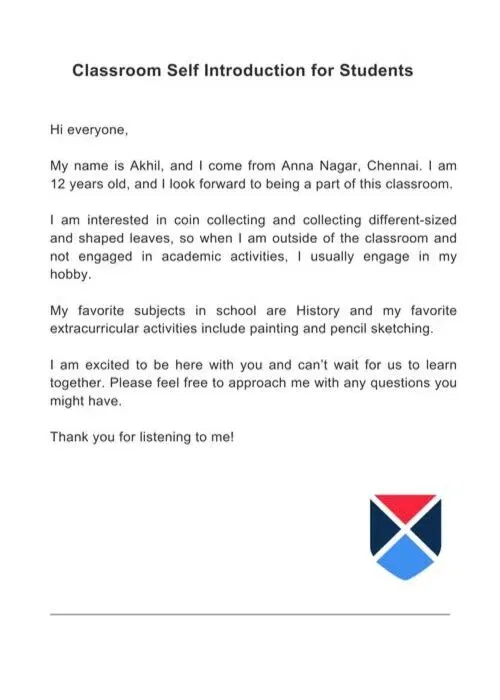
Also Check : 6 Coping Strategies For Student Mental Health
The students can get to know how to draft a good self introduction using the step-by-step guide given below to frame an effective and powerful self introduction amongst the group of audience.
- Step 1: Create an outline of the self introduction
The students must create a synopsis or outline of the self introduction with the crux on what points they are going to include in their self introduction. It will help them decide on what is worth saying and what is not.
- Where the student is from?
- Educational background (degree or class with the institutions name)
- Interests or Hobbies / Life goals (short and long-term)
- Why the student chose to be there that day?
- Exciting call to action
- Ending greetings
- Step 2: Two points for each header in outline
The students can write two format of points on each header mentioned in the outline to understand which format works better for them. The formats could be formal and informat or semi-formal.
- Step 3: Selecting the points from each header
Once the students selects the format (formal, informal, or semi-formal) they'll have to go with the same throughout the self introduction. It is important to stay on track to have an effective and good self introduction for the students to make a confident first impression.
- Step 4: Check the tone of voice and grammar
The students ought to check the tone of voice since it will decide their image and personality in the long run. The self introduction has to be polite and attention worthy. They can also use free online tools to check the grammar of the content to be spoken out.
- Step 5: Speak it out loud
The students last step is to speak the self introduction out loud to decide on the timings, the sentence formation, the order of the points spoken during the self introduction etc. Speaking it out loud will help the students to add or remove points to make the self introduction more attractive.
Also Check : Top 10 Most Effective Stress Management Techniques for Students
Key Elements of Self Introduction for Students
The students must note the key elements to be addressed while performing a self introduction. The pointers are as follows;
- The students will have to mention their full names.
- They have to mention their educational qualification and the institution in which it was pursued.
- If the student is performing a self introduction during an interview then they will have to mention their short-term and long-term goals (one each).
- Practice short 1 minute self introductions to be more concise.
- The students must conclude by being polite and summarizing a good word or two about the introduction experience.
Important Tips for Self Introduction for a Student
The self introduction for students must be impactful, as it is the chance to create a first impression. The points expressed while giving the self introduction must be precise and clear. It is not necessary to include any trivial information to fill in the gaps in the conversation. Find the list of points and tips for a self introduction for students to make an excellent first impression.
- Remember always to wish: By wishing good morning or good evening, a person initiates a conversation and grabs the listeners' attention. It would be better if a student looked confident while starting a conversation.
- Have a purpose: It is necessary to have a better understanding of the motive behind the conversation. Always try to make the conversation impactful and engaging.
- Provide a name: Start by telling your name in a lively voice to make them remember the following words spoken by a particular person.
- Profession: Tell about your work experience, career, or anything related to work. Sometimes it's okay to exclude work experience in the self introduction for students. However, if there are any internships or part-time jobs, students can include those too.
- Location: Speak about your background and area of residence. One may include a native place and tell about its specialty to help them remember the site.
- Hobbies: One may tell them about hobbies, areas of interest, and activities one gets involved in. This can help to know about nature and lifestyle.
- Aims: Mention the objective of life and give a detailed description
- Discuss achievements: Include one's achievements in the introduction, and mention what one has achieved till now. Besides, give 3-5 descriptive achievements in the introduction to make it look impactful.
- Favorite or ideal persons: Include one's perfect person in the introduction, and talk about the reason why they motivate you.
- Favorite things, colors, and movies: If the introduction is casual, students may feel free to tell their favorite movies and other favorite places, colors, etc.
- Strengths and weaknesses: Mention strengths and weaknesses in a self introduction, make sure not to include major flaws, and give a detailed description of the strengths possessed.
- Discuss likes and dislikes: One may include their personal preferences or dislikes in the introduction.
- Any life-changing point: Students may include life-changing moments if students want the listeners to engage in their talk.
- Differentiation: In one's introduction, students should speak about their uniqueness and what makes them stand out, which is the essential aspect of self introduction.
- Conclusion: In conclusion, offers an unforgettable answer to the question the spectators possibly will have when they listen to a public speech: what's in it for me? Describe how different life experiences molded your personality, which will be the perfect ending of the self introduction for students.
- Greeting: Say thank you and exit.
Also Check : 10 Tips for Staying Focused and Productive as A Student
A Self Introduction is a way of introducing oneself to others. It is a brief statement that gives an overview of who you are, where are you from, what you do, and other highlights required.
Self Introduction usually happens when a person is anchoring an event, starting a new job, joining an organization, or meeting new people in social gatherings. A Self Introduction typically includes one's name, profession, education, or field of study and a brief overview of their background and forum-based interests.
Self Introduction for students means introducing and describing themselves in a justified manner. It means highlighting all their unique attributes, and it would be best to be confident and clear enough while introducing themselves to others. A good Self Introduction for students must include the following,
- While introducing yourself, start with a smile on your face and greet the person or audience to whom you are introducing yourself.
- Begin with your 'Name and Place' after the greeting. And if necessary, add family details to the introduction.
- Be brief about educational details, from sharing areas of interest and hobbies to ideas and inspiration.
- Share your prior experience (if any) and recreational activities.
- Give details about the skills.
- Share past experiences, and finally, express your gratitude.
How Important is Good Self Introduction?
A good self introduction for students creates an everlasting impression, and people might be urged to listen to or talk to the person introducing themselves. It builds confidence and enhances one's ability to meet new people and presents themselves well, and makes the atmosphere contended and comfortable having a conversation. It makes a good impression on others. Knowing how to introduce ourselves helps "break the ice" when meeting new people in any place or situation.
Only an individual can know who they are, and it is essential to convey the same to let others know about themselves. By knowing ourselves, one might build enough confidence to face the world in any situation. Thus, one can work solely on producing a masterpiece and develop a positive approach to life.
Also Check : List of 10 Novels for Students to Read
Advantages of Self Introduction
This Self Introduction for students helps build a persona and creates an impactful impression on the people one addresses. Students can grab attention and peak interest with a strong introduction. Below are the advantages of self introduction for students:
- Helps build connections.
- Enhances self-confidence.
- Sharpens presentation skills.
- Builds a favorable impression.
- Enhances the ability to meet people.
- Deep understanding.
- Positive thinking.
- Generated motivation.
- Enhances communication skills.
- One could learn and improve through Self Introduction.
Things to Avoid During Self Introduction for Students
The students must know the things to avoid during self introduction to be projected for confidence and make a good first impression;
- Avoid being too casual or informal while being self introduction.
- Avoid being disrespectful to the person opposite you.
- Avoid a super lengthy introduction instead try a 1 minute self introduction.
- Avoid repeating the contents of your CV or resume.
- Avoid sharing too much personal information.
- Avoid fidgeting while sitting or standing during self introduction.
Also Check: 10 Healthy Habits for Students to Excel in Studies
How to Practice Self Introduction?
The students must practice pointers before self-introducing in public forum. These pointers and tips will help the students to be more conscious during their self introduction.
- Practice and prepare ahead of time before the actual self-introducing event.
- Pay attention to your body language and tone of voice during self introduction.
- Use simple and clear language while introducing yourself.
- Keep practicing until you perfect the speech in front of the mirror to be more self-aware.
- Keep eye contact with the group while introducing yourself.
- Keep a timer while practicing your self introduction and cut short the speech if necessary.
Books for Enhanced English
An impactful self introduction for students includes all the essential details to create an everlasting impression. In addition, students can always refer to and practice with books to improve their language skills. Below is the list of books for enhanced English.
Also Read: Smarter Study Tips for Students to Ace Their Management Exams
What is the time limit for self introduction for students?
How many points does a self introduction for students require?
What is the importance of Self Introduction for students?
POST YOUR COMMENT
Related articles.

Top 5 Educational Podcasts That Are Perfect for Students in 2024

VTU MBA Syllabus 2024: Direct PDF Download Link

Magadh University Syllabus 2024: Download PDF

IGNOU June Revaluation Result 2024

The Benefits of Joining Student Organizations on Campus

Top CUET B.Ed Colleges 2024: Eligibility, Fee, Admission, Counselling

The Impact of Social Media on Students' Mental Health
Get Free Scholarship worth 25000 INR
Self Introduction in English For Students: 5 Easy Ways to Introduce Yourself
Clapingo Team
13 min read

Why is Self-Introduction Important?
5 easy ways to master self-introduction in english, 1. know the basics of self-introduction, 2. structure your self-introduction efficiently, 3. add personal touches to your self-introduction, 4. use conversation starters for engaging introductions, 5. practise self-introduction skills, self-introduction in english for students, self-introduction in english for freshers or job seekers, 1. tailor your introduction to match job requirements or industry norms:, 2. craft an engaging opening statement:, 3. showcase relevant skills and achievements:, 4. use examples to demonstrate your abilities:, 5. end with a strong closing statement:, online resources for self-introduction practice, ending notes.

First impressions are crucial in various situations, whether it's at school, college, job interview, or social events. A well-executed self-introduction can build a positive impression and open doors for networking opportunities. It allows others to get to know you better and shows your confidence and communication skills.
Self-introduction in English for students is an especially important area as in school or college, introducing yourself helps create connections with classmates and teachers that could last for a long time. It sets the tone for future interactions and establishes a welcoming environment. Similarly, during job interview, a strong student self introduction can make you stand out from other candidates and leave a lasting impact on potential employers.
Overcoming shyness is another reason why self-introduction is important. Many students struggle with shyness when speaking in public or meeting new people. By practicing self-introductions regularly, students can boost their self confidence levels and feel more comfortable expressing themselves.
Effective self-introduction also offers networking opportunities. By sharing your interests, skills, and experiences during an introduction, you can attract like-minded individuals who share similar passions or professional goals. This can lead to valuable connections for future collaborations or mentorships.
If you are someone, especially a student, who is struggling with self-introduction, you have come to the right place! In this article, we will guide you through five easy ways to master self-introduction in English. We will also provide you with tips and strategies to improve your self-introduction for various contexts. So let's dive in!
Introducing yourself confidently is a key skill that can open doors to countless opportunities. Whether you're a student, a job seeker, or simply looking to build connections, mastering the art of self-introduction in English is essential. In this section, we will explore five easy ways to help you become an expert at introducing yourself.
The first step towards effective student self introduction is understanding the key elements. When introducing yourself, make sure to include your name, age, occupation, or study, as well as your hobbies and interests. By sharing these details, you create a connection with your audience and give them a glimpse into your personality.
It's also important to consider your target audience and adapt your introduction accordingly. Tailoring your self-introduction based on who you are talking to shows that you value their time and are interested in building a connection.
Additionally, pay attention to clear pronunciation and confident body language while introducing yourself. These non-verbal cues greatly impact how others perceive you and can leave a lasting impression.
Structuring your self-introduction efficiently helps you deliver information effectively. Start with a warm greeting and express gratitude for the opportunity to introduce yourself. This sets a positive tone right from the beginning.
Organize the information logically by using either chronological order or highlighting significant achievements or experiences. For example, if you're introducing yourself in an interview, you might want to start with your educational background before moving on to relevant work experience.
To provide further clarity, here's an example of structuring an introduction:
Greetings: Good morning/Good afternoon/Good evening!
Gratitude: Thank you for this opportunity.
Name: My name is [Your Name].
Occupation/study: I am currently studying [Course/Subject] at [Institution/University].
Hobbies/interests: In my free time, I enjoy [Hobby/Interest].
Remember to practice your introduction to ensure smooth delivery and confidence.
To make your self-introduction memorable, don't hesitate to share unique qualities or experiences that make you stand out from others. Adding personal touches helps create a lasting impression.
For instance, if you have traveled extensively, mention a country or two that left a deep impact on you. If you have won any awards or have unique skills, feel free to share them. These personal touches not only make you more relatable but also spark further conversation.
One way to make your self-introduction more engaging is by using conversation starters. Asking open-ended questions can initiate further dialogue after the introduction, making it easier for others to connect with you.
Here are some sample conversation starters categorized by different scenarios:
This Clapingo article will also provide you with some engaging topics to start engaging conversations: 190+ Creative English Speaking Topics to Speak to Anyone | Clapingo
Like any skill, mastering self-introduction takes practice and preparation. Take the time to rehearse your introduction in front of a mirror or with a friend. This allows you to fine-tune your delivery and build self confidence.
Practicing has several benefits, including reducing anxiety and ensuring a smooth flow of speech during actual introductions. The more familiar and comfortable you become with introducing yourself, the more natural and confident your interactions will be.
Mastering self-introduction in English is crucial for various situations in life. By knowing the basics of self-introduction, structuring your introduction efficiently, adding personal touches, using conversation starters, and practicing regularly, you can confidently introduce yourself in any setting. So go ahead, practice these five easy ways, and make a lasting impression with your self-introductions!
Now let's move on to some context-specific tips and strategies for self-introduction.

Introducing yourself in English can be a nerve-wracking experience, especially for school and college students who may not have had much practice or experience with it. However, with a few simple tips and examples, you can confidently master the art of student self introduction in English. Let's take a look at some of them:
1. Begin with greetings and stating your personal details :
Start your self-introduction with a positive tone and let others know who you are.
Begin by offering a warm greeting.
Clearly state your full name to ensure everyone understands.
Mention your class, section, or the course you are pursuing, and add any additional information related to your studies or field of interest.
Here is an example of a student self introduction in English for college student: "Hi everyone! My name is Sarah Smith, and I am currently enrolled in the Bachelor of Arts program majoring in Psychology."
2. Share a few details about your interests or hobbies :
After introducing yourself, it's good to mention some of your interests or hobbies to help others connect with you on a personal level.
Talk about hobbies that reflect your personality and interests outside of academics.
Highlight activities that demonstrate your passion and dedication.
Remember to keep it concise; sharing one or two hobbies is sufficient.
For example: "Apart from my studies, I enjoy playing the guitar and painting. These activities allow me to express my creativity and relax."
3. Mention any notable achievements or extracurricular activities :
If you have participated in any notable achievements or extracurricular activities, don't hesitate to mention them.
These showcase your skills and dedication outside of academics that could interest others.
For example, you could say "I recently won first place in the inter-school debate competition" or "I am an active member of our school's dance club."
4. Express eagerness to build connections and contribute positively to the class :
Wrap up your introduction by expressing your eagerness to get to know everyone and contribute positively to the dynamics.
Express enthusiasm about being part of the college community.
Show eagerness to learn from others' experiences and contribute positively.
Use phrases like "I look forward to getting to know all of you" or "I am excited about the opportunities this college offers."
For example: "I am thrilled to be part of this vibrant school/college community, and I can't wait to meet new people, learn from each other, and make lifelong connections."
By following these simple tips, you'll be able to introduce yourself effectively in English and make a positive impression on your classmates and teachers. This article can also be helpful. Remember to be authentic, positive, and open to building new relationships.

When it comes to job interviews or networking events, self-introduction plays a crucial role in making a positive first time impression. An effective job interview introduction can help you stand out from the crowd and showcase your skills and qualifications. Here are five easy ways to introduce yourself in English for freshers or job seekers.
Before attending an interview or networking event, research the company and understand the job requirements. Tailor your self-introduction accordingly to highlight relevant skills and experiences that align with the position. Use industry-specific terminology to demonstrate your knowledge and interest.
Your opening statement should be concise, confident, and attention-grabbing. Begin by stating your name and expressing enthusiasm for the opportunity. Highlight any outstanding achievements or relevant experiences that make you a strong candidate for the role.
During your self-introduction, mention key skills and accomplishments that are relevant to the job you're applying for. This could include certifications, internships, projects, or any other experiences that demonstrate your expertise in the field.
Instead of simply listing your skills, provide specific examples that showcase how you have utilized those skills in previous positions or projects. This helps employers visualize how you can contribute to their organization.
Conclude your self-introduction by expressing gratitude for the opportunity and summarizing why you believe you're a suitable candidate for the role. Invite further conversation by asking about the next steps in the hiring process or expressing interest in learning more about the company.
By following these five easy ways, you can effectively introduce yourself in English as a fresher or job seeker, leaving a lasting impression on potential employers or professional connections. As a fresher or job seeker hoping to up your career, this Clapingo article can also be helpful to you: Is Practicing Speaking English All it Takes to Advance Your Career? Clapingo Blog | 2022 . Good luck with your self-introductions!
Seeking professional guidance and practice is key to improving your communication skills. Fortunately, there are several online course and resources available that can help you ace your self-introduction game. Let's explore some of these platforms:
1. Clapingo : As an online platform specializing in Spoken English Classes, Clapingo offers comprehensive courses specifically designed to improve self-introduction in English for students. Their experienced coaches provide expert guidance and personalized feedback, ensuring effective learning. You can also check out other online resources available and choose what feels best to you: Top 8 powerful English speaking courses in 2022 Guide - Clapingo .
2. YouTube : The popular video-sharing platform is a treasure trove of free resources for learning self-introduction in English. Alongside numerous tutorial videos, expert tips, and sample introductions, movies can also serve as an excellent resource to observe and learn from real-life scenarios. Watching movies allows you to see how characters introduce themselves in various contexts, providing a rich, contextual understanding of language and presentation skills.
3. Online Forums and Discussion Boards : Participating in online forums such as Reddit or Quora can provide opportunities for students to introduce themselves in written form or engage in discussions related to student self introduction. You can seek feedback from other users or join conversations where self-introductions are shared.
Incorporating these online resources into your learning journey will undoubtedly enhance your ability to confidently introduce yourself in English, opening doors to new opportunities in academics, career, and social settings. So don't hesitate, to take advantage of these resources and start perfecting your self-introduction skills today!
You can also check out Clapingo's YouTube channel for an interview-specific crash course that details self-introduction. Here's a video from the series:
Knowing how to introduce yourself effectively is a valuable skill that can open doors and create opportunities. By mastering the art of self-introduction, you can make a lasting impression in various situations, whether it's at school, college, job interview, or social events. The concept of "student self introduction" is particularly important as it helps in setting a positive tone for future interactions, showcasing your skills, and highlighting your interests and goals.
In this blog post, we've discussed five easy ways to introduce yourself in English. These strategies include knowing the basics of self-introduction, structuring your introduction efficiently, adding personal touches, using conversation starters for engaging introductions, and practicing self-introduction skills.
Implementing these techniques will help you build confidence, establish connections, and leave a positive impact on others. Remember to adapt your introduction according to the target audience and use clear pronunciation and confident body language to make a strong first impression. So go ahead and apply these tips in your daily life!
Now that we've covered the importance of self-introduction in English for students and job seekers, and provided you with practical tips for mastering this skill, it's time for you to put them into action. So don't hesitate to step out of your comfort zone and seize every opportunity to introduce yourself confidently in English. Most importantly, believe in yourself and showcase your enthusiasm when introducing yourself.
To prepare yourself before the course begins, engage in pre-course practice activities that focus on foundational skills. Such as Spoken English Syllabus .
1. How to write a self-introduction in English for college students?
When writing a student self introduction for college, start with a confident greeting and then state your name, course, and any relevant information. Share your interests or hobbies briefly to spark conversations. Finally, end with a positive closing statement that invites others to connect.
2. How to give a self-introduction in English in college?
For an interesting self-introduction in English for college students, begin with a confident and positive note. Share a few personal details about you and express your eagerness to build connections and contribute positively to the class.
3. What should be included in a self-introduction in English for class 12 students?
For class 12 students, when giving a self-introduction in English at school, it's important to start with greetings and introduce yourself by stating your name, grade, and section. Talk about your interests that can help you connect with your classmates. Mention any notable achievements or extracurricular activities you have participated in as well.
Self introduction in English
English for interview
introduction for students
Free Leadership Course Delivered to Your Email
Learn to speak English like leader. Get our Leadership course at NO COST.
Clapingo connects you with fluent and dynamic English Speakers from India with diverse backgrounds and professions. Practice English conversation over live video calls. Transform your English speaking skills by talking to excellent English speakers over 1-on-1 video calls.
You may also want to read

Clearing Up 'Wont' and 'Won't': When to Use Each Correctly
wont vs won't difference

Shedding Light on Lightening and Lightning: Understanding the Contrast
lightening vs lightning

Gone vs. Went: Parsing the Verb Tense Forms
gone vs went difference
- PRO Courses Guides New Tech Help Pro Expert Videos About wikiHow Pro Upgrade Sign In
- EDIT Edit this Article
- EXPLORE Tech Help Pro About Us Random Article Quizzes Request a New Article Community Dashboard This Or That Game Popular Categories Arts and Entertainment Artwork Books Movies Computers and Electronics Computers Phone Skills Technology Hacks Health Men's Health Mental Health Women's Health Relationships Dating Love Relationship Issues Hobbies and Crafts Crafts Drawing Games Education & Communication Communication Skills Personal Development Studying Personal Care and Style Fashion Hair Care Personal Hygiene Youth Personal Care School Stuff Dating All Categories Arts and Entertainment Finance and Business Home and Garden Relationship Quizzes Cars & Other Vehicles Food and Entertaining Personal Care and Style Sports and Fitness Computers and Electronics Health Pets and Animals Travel Education & Communication Hobbies and Crafts Philosophy and Religion Work World Family Life Holidays and Traditions Relationships Youth
- Browse Articles
- Learn Something New
- Quizzes Hot
- This Or That Game New
- Train Your Brain
- Explore More
- Support wikiHow
- About wikiHow
- Log in / Sign up
- Education and Communications
- College University and Postgraduate
How to Introduce Yourself in College
Last Updated: September 26, 2023 Fact Checked
This article was co-authored by Ashley Pritchard, MA . Ashley Pritchard is an Academic and School Counselor at Delaware Valley Regional High School in Frenchtown, New Jersey. Ashley has over 3 years of high school, college, and career counseling experience. She has an MA in School Counseling with a specialization in Mental Health from Caldwell University and is certified as an Independent Education Consultant through the University of California, Irvine. There are 9 references cited in this article, which can be found at the bottom of the page. This article has been fact-checked, ensuring the accuracy of any cited facts and confirming the authority of its sources. This article has been viewed 250,517 times.
Going off to college is an exciting time. You’ll get to meet new people, learn new things, and have tons of new experiences. Along with all this, they’ll be moments when you have to introduce yourself. So, we’ve put together this helpful list of tips for introducing yourself in a college environment. There are ideas for different situations, so take a look at them all and pick out what works for you.
Speak clearly and loudly when you say your name in a class.

- For example, instead of looking at the floor and murmuring your name, look around the room at classmates and say your name in an assertive voice.
- It's also important to make eye contact while you speak. This will make you appear more confident and self-assured, even if you don't feel it!
Tell the class something memorable about yourself.

- For example, you might say, "Hi, I'm Raj and I taught scuba diving over the summer." You could then tell a funny story from teaching the class if you have enough time.
- You could also tell your class where you're from and something interesting about the place. For example, if you’re from Roswell, New Mexico, say you’re from the UFO capital of the world!
Explain your academic interests so others know why you’re there.

- You could say, "I've always loved to write and I'm interested in current events, so I'm a journalism major."
- If you don't know what you're going to major in yet, don't worry! You can tell the class that you're undecided or just mention a few courses you're taking this term.
Mention some hobbies and interests to make friends.

- For example, you could say, “I love to rock climb and I’ve heard there are some good spots nearby. If anyone wants to partner up and go climbing, let me know after class!”
Practice your brief introduction speech before college starts.

- If it helps, ask a friend or family member to watch you speak. They can give you useful feedback or offer encouragement.
- Try to limit your introductions to under 1 minute long. You probably won’t get a lot of time to talk when you introduce yourself in classes, so this helps ensure you can fit in everything you want to say.
Follow the instructor's prompts for intros in online courses.

- It might be tempting to rush through the introductory post and reply with vague basics, but remember that taking the time to make thoughtful posts will make you feel more invested in the course.
Share personal and professional details in your online intro.

- You might say, "I'm Alex and I took a few years off of school to start my own photography business. Unfortunately, I'm a great photographer, but not such a great business person. I'm hoping to learn some financial tips from this course for running my own business."
Upload a picture if you want online classmates to see your face.

- If you don't feel comfortable uploading a picture of yourself, you should be able to select an image or avatar that represents your interests.
- You might need to upload a video introduction too. If so, write a brief introduction as though you were going to give it in person. Practice before filming and uploading the video.
Respond to a classmate's introduction online to break the ice.

- For example, you might reply to a classmate's introduction by saying, "Hi, Zara, it's great to meet you. I'm also a math major so maybe we'll be in other classes together!"
Get involved on campus to meet people outside of class.

- For example, if you’re into sports, you could look for an intramural soccer team or dodgeball team to join.
- Other ways you can get involved and meet others on campus include getting an on-campus job, doing research with a professor, or finding an internship.
Say hi to people you see around the dorms or on campus.

- It’s fine if not everyone you say hi to turns into a friend or even an acquaintance, but putting yourself out there helps people get to know you as well and lets them know you might be open to talking or hanging out.
Invite people to study or hang out if they seem interesting to you.

- You could even try to form a study group for a class or find a group of people who like to do the same activities to hang out with multiple new people.
Introduce yourself confidently if you have a college interview.

- Make eye contact and smile so you appear self-assured, even if you feel a little nervous!
- A lot of interviewers will start things off by asking you to tell them about yourself. Keep things conversational while you let them know a few key facts about where you're from, your educational background, or jobs that you've had.
- Remember to thank the interviewer for their time before leaving.
Expert Q&A

You Might Also Like

- ↑ Ashley Pritchard, MA. Academic & School Counselor. Expert Interview. 4 November 2019.
- ↑ https://hbr.org/2022/08/a-simple-way-to-introduce-yourself
- ↑ https://www.helpguide.org/articles/relationships-communication/making-good-friends.htm
- ↑ https://professional.dce.harvard.edu/blog/10-tips-for-improving-your-public-speaking-skills/
- ↑ https://www.devry.edu/blog/how-to-introduce-yourself-in-an-online-college-class.html
- ↑ https://ctb.ku.edu/en/table-of-contents/leadership/leadership-functions/build-sustain-relationships/main
- ↑ https://www.edutopia.org/discussion/social-and-academic-benefits-team-sports
- ↑ https://au.reachout.com/articles/what-makes-a-good-friend
- ↑ https://www.torrens.edu.au/blog/the-5-big-benefits-of-studying-with-friends-and-how-it-could-save-you-money
About This Article

College is a great place to meet new people and build your social skills. If you need to introduce yourself in class, speak clearly and confidently. Tell everyone your name and say something memorable about yourself. For instance, you might mention an unusual skill or an interesting experience you had. In a class setting, it’s also a good idea to talk about your academic interests or your area of study. If you’re meeting other people outside of class, keep it a little more casual. Smile, say hi, and tell them your name. Say something about your hobbies, since that can be a great way to find common interests. If you feel a connection with someone, don’t be afraid to invite them to hang out or study with you. Did this summary help you? Yes No
- Send fan mail to authors
Reader Success Stories
Aug 26, 2022
Did this article help you?
Sarath Nair
Dec 30, 2022

Featured Articles

Trending Articles

Watch Articles

- Terms of Use
- Privacy Policy
- Do Not Sell or Share My Info
- Not Selling Info
wikiHow Tech Help Pro:
Develop the tech skills you need for work and life
What are your chances of acceptance?
Calculate for all schools, your chance of acceptance.
Your chancing factors
Extracurriculars.
What to Say in a College Interview: Responding to ‘Tell Me About Yourself’
What’s covered:, setting the tone, topics to cover, 4 examples of how to respond, topics to avoid, 5 tips to prepare for this prompt.
Are you worried about your admissions interview? If so, you’re not alone. Many students are like you and want to be as well-prepared as possible, which means anticipating and practicing responding to the questions you will be asked ahead of time.
While there’s no way of knowing exactly what you’ll be asked, there’s one question you can always prepare for — the classic, “Tell me about yourself.” Although this question may seem open-ended (and daunting), there are some tips and tricks you can rely on to ensure your response is informative, personal, and natural.
In this post, we’ll outline why this question is important, the topics you should cover in your answer, and a few example responses to inspire your preparation!
You should see the “tell me about yourself” prompt as an opportunity to show the interviewer your most important qualities and give them an initial sense of how you might contribute to the school’s community. In any interview you have over the course of your college years and beyond, this prompt is meant to give the interviewer an idea of what you would bring to the position at hand — in this case, as a member of the college’s matriculating class.
Unsurprisingly, you want to talk about yourself and your background, but in a focused way that paints an accurate portrait of yourself as a productive, insightful member of the incoming freshman class. Stand-alone details and dead-end stories are rarely relevant in answers to this kind of question. Additionally, this is not an invitation to share your life story or overly personal information with your interviewer — doing so will make you appear unprofessional and unprepared.
That being said, you won’t want to sound like just another drone looking to fulfill pre-med requirements at any old college with a good biology program. So, you also want to be careful to not just rattle off a bullet-point list of repetitive or generic information. Rather, you should work to connect your unique past experiences with your future goals, and to explain why this institution is the perfect place for you to achieve those goals.
You should also be aware that this will often be the interviewer’s first question, which means it will set the tone for the rest of the interview. Starting strong is especially important since most college interviewers are alumni volunteers who haven’t, and won’t, see your grades, essays, or anything else in your application. Since they won’t have any prior familiarity with your profile, part of your responsibility when responding to this question is to lay a solid foundation for the rest of the interview, by having a thoughtful, cohesive, but not overly rehearsed answer at the ready.
There’s no one right way to respond to this question, because for different students, certain aspects of their lives will be more or less relevant to understanding who they are. That being said, here is an initial list of topics that many students end up discussing in their answers:
- Where you grew up
- What you want to study (and why)
- Unique personality traits
- Academic interests
- Extracurricular activities
- Why you want to attend the college
Keep in mind that you probably don’t want to talk about every single one of these things, as you don’t want your answer to be too long — about 2-3 minutes maximum. While this question is important, you have a whole interview to go, so you don’t need to jam every single thing you want to say into your first answer. You’ll have plenty of other opportunities to discuss things you don’t get to in this first response. Plus, your interviewer may feel awkward if you start off by monologuing at them for 10 minutes, or confused if you mention dozens of unrelated things.
In general, though, it is a good idea to begin by mentioning the area in which you grew up, or some other foundational aspect of your upbringing, like your parents’ professions or your cultural heritage. Don’t spend too much time discussing the intricacies of your hometown or home life, but try to connect where you’re coming from to your interest in the college’s location, size, or campus culture.
You’ll also want to tell the interviewer about your prospective major, if you have one, or, if you’re undecided, what some of your main areas of interest are. While laying out your academic background, describing two or three of your most important broader personality traits will give your interviewer a clearer sense of why these subjects are important to you. You may also touch on a key extracurricular that further illuminates who you are. End your answer with a quick explanation of why you want to attend this particular college.
Since you should have researched the school thoroughly before the interview, you will hopefully already have a good idea of how your personality, as well as academic and extracurricular interests, will fit in there. Your response should concretely connect your personal strengths and experiences to the school’s offerings and overall culture.
Crucially, you shouldn’t assume that your interviewer can figure out how your background aligns with the school’s culture on their own. While they are obviously familiar with the school, colleges and universities have hundreds if not thousands of different opportunities available, so they may not have heard of the offerings in your particular area(s) of interest. Be clear about why and how your past experiences have set you up to succeed at this institution.
Finally, admissions officers want to be confident that you’ll accept your offer of admission, if you receive one. So, you should make sure to express how interested you are in attending this particular school, rather than speaking about broad goals for college that you could achieve anywhere.
Response #1
“ I grew up in a small town in Connecticut and have lived there my whole life, so I’d really love to experience city life in college. Since I live relatively close to New York, I’ve had the opportunity to visit a few times, and it has so much to offer, especially in terms of the literary scene. I love reading and writing, so I’m thinking of majoring in English or journalism. Journalism seems like a good fit because I’m good at noticing details and know how to dig to the core of an issue.
My attention to detail is something I’ve been able to rely on to help me overcome challenges. Junior year, I was having a hard time in trig. When I met with my teacher outside of class, though, we were able to determine that I had a solid grasp of simple concepts like sine and cosine, but was struggling with bigger picture concepts. Moving forward, breaking down tricky problems into their core ideas and solving them one step at a time proved to be an effective strategy for me, and I ended up earning an A in the class.
In general, though, my interests are more humanities leaning. I especially enjoy writing and foreign languages, which is why I’m a columnist for my school newspaper and the president of the Spanish club. I also tutor English and Spanish at an after-school program in my town.
NYU seems like the perfect school for me because it has such strong English and journalism programs, including honors programs in both fields, and amazing study abroad programs through its campuses all over the world–I’d love to learn Italian, Chinese, or Arabic to become tri- or even polylingual!”
This interviewee touches on her interests in a way that shows her qualifications to attend NYU. She references her passion for English, journalism, and foreign languages several times throughout her response, and explains what she has done to explore them both inside and outside school. At the end of her response, she also identifies specific attributes of NYU that appeal to her (honors programs in English and journalism; campuses around the world), which clearly fit with the details she’s provided about her own background.
Additionally, she reveals some of her key personality traits, such as her attention to detail and her resilience, and provides examples that illustrate these attributes. These examples make her response memorable, whereas if she were to just say “I’m a resilient person with good attention to detail,” it would come across as cliché or generic.
Response #2
“As a kid, I frequently visited family in Los Angeles. During those trips, my aunt would take me to see musicals at the Orpheum Theatre, which sparked my love for drama. Since then, I’ve been in over 30 musicals at my school and through my local theater, although my favorite role still has to be Georg von Trapp in “The Sound of Music.” I’m planning to major in musical theater because being in so many productions has made me a talented singer and dancer, and I’m confident in my own skin, both on-stage and off-stage.
I wasn’t always confident, though. Despite my passion for theater, I was incredibly shy as a kid. It took me several years to work up the courage to even audition for a show. I am grateful for how my involvement in theater has helped me become more secure in expressing myself. I also work as an instructor for elementary-aged students at a local dance studio, and I try to bring out that same confidence in them.
Aside from theater, I’m really passionate about reading. I started a book club at my high school that meets weekly, and I also run a book blog, where I analyze and review novels I read. I find that this side project helps me connect more deeply with the characters I play on stage.
I’d love to attend UCLA because the Ray Bolger Musical Theater Program will give me the opportunity to grow and develop my skills as an actress. As an avid reader, I’m also extremely interested in UCLA’s Comparative Literature minor. Plus, Los Angeles is the ideal location for an aspiring actor to launch his career.”
This response is centered on one of the interviewee’s particular interests, his associated professional goals, and how the school could help him achieve them. He highlights his major of interest (musical theater), and explains how his involvement in theater has helped him become more confident and better and expressing himself — some of his key personality traits.
This interviewee’s discussion of his academic and extracurricular interests frames him as someone who is prepared to thrive at UCLA. Most importantly, though, he doesn’t leave that to be inferred by his interviewer. Rather, he gives relevant, personal reasons for why he’s interested in attending UCLA related to the university’s programs and location.
Response #3
“I come from three generations of farmers. My family lives on a corn farm in a small town in Nebraska. I always thought I would be a farmer, just like my dad, until my family took a vacation to Hawaii after my freshman year of high school. We went snorkeling almost every day, and I became fascinated with marine life. When we returned home, I started researching marine biology majors, and since then, I’ve been set on studying marine biology at the University of Maine.
As part of my pursuit of this goal, last year I became scuba certified, and I started bi-weekly diving lessons at the nearest scuba diving school. It’s a 75-minute drive from where I live, so I’m proud of my determination to continue attending the classes, even when they conflict with my busy schedule. I also play on the football and basketball teams, am the student council secretary, and help my dad on the farm on the weekends.
I’d love to attend the University of Maine because it has such a large concentration of professors who specialize in marine sciences, and access to two research centers, the Darling Marine Center and Aquaculture Research Center. And after spending 18 years of my life landlocked in Nebraska, I am excited for the chance to live near the coast!”
This interviewee tells a compelling story about how he unexpectedly became interested in his intended major, marine biology, and how that in turn led him to apply to the University of Maine. He also shares a story that showcases one of his best character qualities, determination, and how it has helped him advance towards his goal of becoming a marine biologist.
The student also shares some of his on-campus and off-campus extracurriculars to showcase that he is well-rounded. He ends by describing why the University of Maine is a great fit for him, and the unusual perspective he could bring to campus.
Response #4
“I grew up in Atlanta, but my family spends every summer at Tybee Island. I love that Savannah offers a similar small-town feel with plenty of history, art, and culture. It’ll be a refreshing reprieve from the big city, while still providing ample opportunity for an aspiring artist.
I’ve been artistic for as long as I can remember. Growing up, I was always painting, sketching, or drawing. When I was young, my dream was to move to Paris after high school to be an artist. So I started taking French in eighth grade, and now, I’m nearly fluent. However, as college neared, my pragmatic side convinced me to get a degree that led to a more secure career path. Graphic design seemed like a great option because it would give me an avenue to still pursue art, while leaving plenty of professional doors open.
SCAD’s graphic design program is particularly appealing to me because of how many events the program hosts for students to learn from graphic designers who have been successful in the world of business. The cutting-edge technology and facilities available to students will also ensure I’m ready to use all the tools I’ll need as a professional. Maybe most importantly, I’m also interested in studying abroad at SCAD Lacoste to practice my French and finally fulfill my dream of creating art in France!”
In this response, the interviewee explains how her background led her to discover both her major, graphic design, and SCAD. The student highlights her qualifications as an artist, while also giving her interviewer a more nuanced understanding of who she is by describing her practical side.
One unique, especially satisfying part of this response is that the student connects a life-long dream of hers (creating art in France) to a specialized study-abroad program offered by SCAD. Thanks to this connection, her answer comes full circle, which makes it feel like a single, cohesive unit.
Although the “tell me about yourself” prompt may seem entirely open-ended, there are specific things the interviewer does want to learn about you as a candidate, while other aspects of your life may be irrelevant or even inappropriate to mention. Your interviewer does not need to learn everything there is to know about you.
For example, don’t tell your interviewer about personal hobbies that aren’t relevant to the school or interview, or talk too much about friends, family, and other aspects of your life that don’t show your potential as a college student. You should also avoid saying anything negative about the school, or indicate that you are not particularly invested or interested in attending it.
Weak Response #1
“I grew up in a small town in Connecticut, but I don’t want to stay here. It’s just a little too small. I’m not entirely sure what environment I want to live in as an adult, though. Mainly, I want to enjoy myself while I figure it out, and some neighborhood friends of mine have told me the weather and school spirit at USC are unparalleled!
I definitely want to study Hotel Management, though. My mom’s whole family works in hospitality, so I’ve seen firsthand how many great perks there are if you’re in the industry. For example, my parents don’t make a lot of money, but we’ve been able to travel a lot thanks to discounted stays. I’m looking forward to further broadening my horizons in college, maybe through a study abroad program or just meeting peers from other places in the world.”
While this interviewee comes across as well-intentioned, there are several red flags. First, he doesn’t seem to have any personal connection to USC, and only chose to apply based on others’ recommendations. Feeling uncertain about your future is completely normal, and even something you can discuss in your college interview. However, you want to provide personal, specific reasons why this school will give you more direction, not give only vague or shallow reasons for applying.
Another, related issue is that USC doesn’t have a hotel management major. While the interviewer may not know every program offered off the top of their head, they are going to write a report for the admissions committee after your conversation. Admissions officers are incredibly well-versed in what their institution offers, so they’ll immediately see that this student isn’t genuinely interested in USC.
Finally, even if USC did offer hotel management, this student’s reasons for wanting to study the field come across as superficial, and not rooted in genuine intellectual curiosity. Wanting to travel isn’t inherently a bad goal, but the student should have connected it to his interest in the history of other parts of the world, a desire to learn another language, or something else with more of an academic focus. He also should have been more specific about how USC will help him broaden his horizons, as studying abroad or meeting peers from different backgrounds are things you could do at any school.
Weak Response #2
“Because I grew up in Seattle, my summers were always full of camping or backpacking trips, and I became a total nut about the outdoors as a result. So, when it came time to apply to college, I knew Dartmouth was the place for me.
Dartmouth is also a good fit for me academically, because of the unique possibility of modifying your major. I love economics, but I also have a humanities lean and enjoy learning about American history, so it’s great I won’t have to pick one or the other. And, even though it’s far from home, both my parents went to Dartmouth and I have an aunt in Vermont, so I don’t think I’ll have any trouble making Hanover my home away from home.”
The biggest issue with this response is that the student is making her interviewer do her work for her. While Dartmouth is indeed known to be an outdoorsy school, she doesn’t mention anything specific that tangibly captures that general reputation. Her response would be much stronger if she mentioned something like the First Year Trips program as a means of building community, or her desire to get involved in a Dartmouth Outing Club sub-club to learn a new skill like canoeing.
Similarly, the modified major is unique to Dartmouth, but the student doesn’t explain how she would take advantage of it. Just stating that she has multiple interests isn’t sufficient, because that will be true of just about every applicant to Dartmouth — she needs to describe the intersection(s) she sees between economics and American history, and how the modified major will help her explore them more productively than, say, just double majoring, which you can do at nearly any school.
Finally, while it’s okay to mention connections you have to the school or surrounding area, you need to illustrate how they’ve shaped your own perspective on the institution. For example, this student could talk about how she was originally apprehensive about attending school in such a small town, but attending reunions with her parents showed her that the strength of the Dartmouth community fends off feelings of isolation. Right now, though, that personal element is missing, and thus saying her parents are Dartmouth alums just comes across as name-droppy and braggy.
It’s almost guaranteed that this “Tell me about yourself” question will come up during your interview, often as the very first question. To ensure you aren’t caught off-guard, here are some tips for how you can prepare:
1. Reflect on the Past
Brainstorm at least five important events in your life that have helped shape you into who you are today. Ideally, these events will align with your major and broader goals for the future. Sift through them to decide which story is most relevant to understanding what you have to contribute to a college campus.
It’s especially wise to choose an event that connects to some of your most important character traits. That way, your interviewer will start to get a sense of who you are not only as a student, but as a whole person.
2. Evaluate Your Interests
What are your favorite classes? What clubs or teams are you a part of? Did you start an organization yourself, or do you have a leadership position? What hobbies do you have when you’re not at school? Do you have a part-time job you love?
Your academic and extracurricular interests are given a great deal of weight by college admissions officers. In your interview, you want to be able to easily reference specific examples of how you’ve pursued your passions, as well as how you developed them, so that your interviewer gets to see your eyes light up, so to speak, and gets a clearer sense of what sets you apart from other applicants.
3. Pinpoint Your Major
If you’ve decided on a major, highlight why you’re interested in this major and why the university is ideal for this area of focus. If you’re still undecided, that’s perfectly fine, but you should be able to discuss your broader academic interests and why this college is a good place for you to hone in on one particular area.
For example, maybe you’re interested in medicine, but also love animals, and don’t know if you want to be a doctor or a veterinarian. You might talk about how Washington State University has excellent graduate schools in both fields, with plenty of courses and extracurriculars available to undergrads as well, and thus is the perfect place for you to figure out which path is right for you.
4. Research the University
One of the best ways you can stand out from other students while answering this question is to connect your background to programs, classes, professors, and other unique offerings at the college, and explain how these resources will launch you into your future. These school-specific details will not only make your answer more thorough, but will also demonstrate that you are well-prepared and genuinely interested in attending the college.
Make sure, though, that you aren’t just saying something generic that could apply to any institution. Perhaps you’ve heard that a school has great professors, but that’s true of most colleges. So, you’ll want to instead zoom in on one or two particular professors whose work aligns well with your own interests, so that your interviewer can clearly see what sets this school apart in your mind.
5. Practice, Practice, Practice
After thinking about how you’ll answer the question, it’s important to run through your response with family and friends. Although you don’t want to sound too rehearsed, as you can then come across as stiff, you also don’t want to be stumbling over your words. Plus, those close to you may have suggestions for details you might include that you didn’t think of yourself.
How Much Do College Interviews Matter?
College interviews matter , but they won’t make or break your application. In fact, they account for only around 5% of an admissions decision. That said, they are a great way to showcase your personality and character, your ability to engage in conversations and answer questions, and your overall maturity and professionalism. Your college interview is unique in that it allows you to put a face, personality, and voice to your name, so you still want to take it seriously and prepare thoroughly.
You can also use your interview as a way to determine if the university is the right fit for you. After all, you’ll likely be matched with an alum who will be able to answer questions about their experience at the school — their insights could be invaluable if you’re eventually accepted and need to decide between this institution and your other options!
That being said, other factors such as academics and extracurriculars will have a much larger impact on your chances of acceptance. If you’d like to know how your profile stacks up, we recommend using our free chancing engine . This tool will give you personalized odds of acceptance at over 1500 schools in the US, based on how well your profile aligns with that of an average accepted student!
Related CollegeVine Blog Posts


Effective Self-Introductions (Inspiring Examples and Scripts)
By Status.net Editorial Team on September 22, 2023 — 21 minutes to read
- Structure of a Good Self-introduction Part 1
- Examples of Self Introductions in a Job Interview Part 2
- Examples of Self Introductions in a Meeting Part 3
- Examples of Casual Self-Introductions in Group Settings Part 4
- Examples of Self-Introductions on the First Day of Work Part 5
- Examples of Good Self Introductions in a Social Setting Part 6
- Examples of Good Self Introductions on Social Media Part 7
- Self-Introductions in a Public Speaking Scenario Part 8
- Name-Role-Achievements Method Template and Examples Part 9
- Past-Present-Future Method Template and Examples Part 10
- Job Application Self-Introduction Email Example Part 11
- Networking Event Self-Introduction Email Example Part 12
- Conference Self-Introduction Email Example Part 13
- Freelance Work Self-Introduction Email Example Part 14
- New Job or Position Self-Introduction Email Example Part 15
Whether you’re navigating a job interview, networking event, or simply meeting new people, the way you introduce yourself sets the tone for the entire interaction. In this comprehensive guide, we’ll equip you with the essential tools and techniques to confidently and effectively introduce yourself in any situation, leaving a lasting and positive impression.
Part 1 Structure of a Good Self-introduction
- 1. Greeting and introduction: Start by greeting the person you’re speaking to and introducing yourself. For example, “Hi, my name is Jane. Nice to meet you!”
- 2. Brief personal background: Give a brief overview of your personal background, such as where you’re from or what you do. For example, “I’m originally from California, but I moved to New York a few years ago. I work in marketing for a tech company.” Related: 10 Smart Answers: “Tell Me About Yourself”
- 3. Professional experience: Highlight your relevant professional experience, including your current or previous job titles and any notable achievements. For example, “I’ve been working in marketing for about 5 years now, and I’m currently a Senior Marketing Manager at my company. Last year, I led a successful campaign that resulted in a 20% increase in sales.” Related: How to Describe Yourself (Best Examples for Job Interviews)
- 4. Skills and strengths: Mention any skills or strengths that are relevant to the conversation or the situation you’re in. For example, “I’m really passionate about data analysis and using insights to inform marketing strategy. I’m also a strong communicator and enjoy collaborating with cross-functional teams.” Related: 195 Positive Words to Describe Yourself [with Examples] 35 Smart Answers to “What Are Your Strengths?” What Are Your Strengths And Weaknesses? (Answers & Strategies)
- 5. Personal interests: Wrap up your self-introduction by mentioning a few personal interests or hobbies, which can help to humanize you and make you more relatable. For example, “In my free time, I love hiking and exploring new trails. I’m also a big fan of trying out new restaurants and cooking at home.”
- Related: Core Values List: 150+ Awesome Examples of Personal Values Best Examples of “Fun Facts About Me” What Are Your Values? How to Discover Your Values
Part 2 Examples of Good Self Introductions in a Job Interview
When introducing yourself in an interview, you should be confident, clear, and knowledgeable. Maintain eye contact, speak with a steady tone, and be concise. Prepare your introduction beforehand to avoid stumbling or getting too wordy. Try to cover these aspects:
- Current or most recent position/job
- A relevant accomplishment or strength
- Why you are excited about the company or role
Templates and Scripts
“Hello, my name is [Your Name], and I recently worked as a [Your Most Recent Position] at [Company/Organization]. I successfully managed a team of [Number] members, achieving a [Relevant Accomplishment or Growth]. I’m excited about the opportunity at [Interviewer’s Company] because [Reason Why You’re Interested].”
“Hi, I’m [Your Name], a [Current Job Title or Major Accomplishment]. I’m passionate about [Relevant Industry or Skillset] and have a proven track record of [Specific Result or Achievement]. I believe my skills and experience make me well-suited for this role at [Company], and I’m excited to explore how I can contribute to [Company Goal or Project].”
“Hi, my name is Jane Doe, and I’m the Assistant Marketing Manager at ABC Corp. I recently implemented a successful social media campaign, which increased engagement by 30%. I’m thrilled about the possibility of working with XYZ Inc. because of your innovative marketing strategies.”
“Hello, I’m John Smith, a financial analyst with five years of experience in the banking industry. I’ve consistently exceeded sales targets and helped my team win an award for excellent customer service. I’m excited to join DEF Ltd. because of your focus on sustainable and responsible investing.”
Remember to tailor your introduction to the specific interview situation and always show enthusiasm for the position and company. This will show the interviewer that you are the right fit.
Related: How to Describe Yourself (Best Examples for Job Interviews)
Part 3 Examples of Good Self Introductions in a Meeting
General tips.
When introducing yourself in a meeting, consider these tips:
- Start with a greeting: Begin with a simple “hello” or “good morning.”
- State your name clearly: Don’t assume everyone knows you already.
- Mention your role in the company: Help others understand your position.
- Share relevant experience or accomplishments: Give context to your expertise.
- Be brief: Save detailed explanations for later conversations.
- Show enthusiasm: Display interest in the meeting and its objectives.
- Welcome others: Encourage a sense of connection and camaraderie.
Here are some templates and scripts to use when introducing yourself in a meeting:
- Basic introduction : Hi, I’m [Name], and I work as a [Your Role] in the [Department]. It’s great to meet you all.
- Involvement-focused : Good morning, everyone. I’m [Name], [Your Role]. I handle [Responsibility] in our team, and I’m looking forward to working with you on [Project].
- Experience-based : Hello! My name is [Name] and I’m the [Your Role] here. I’ve [Number of Years] of experience in [Skills or Industry], so I hope to contribute to our discussions during the meeting.
Here are some examples of self-introductions in different scenarios:
- New team member : Hi, I’m [Name]. I just joined the [Department] team as the new [Your Role]. I have a background in [Relevant Experience] and am excited to start working with you on our projects!
- External consultant : Hello everyone, my name is [Name], and I’m here in my capacity as a [Your Role] with [Your Company]. I specialize in [Skill or Industry], and I’m looking forward to partnering with your team to achieve our goals.
- Guest speaker : Good morning, I’m [Name], a [Your Position] at [Organization]. I have expertise in [Subject], and I’m honored to be here today to share my insights with you.
Related: 10 Smart Answers: “Tell Me About Yourself”
Part 4 Examples of Casual Self-Introductions in Group Settings
Template 1:.
“Hi, I’m [your name], and I’m a [profession or role]. I love [personal hobby or interest].”
“Hi, I’m Emily, and I’m a pediatric nurse. I love gardening and spending my weekends tending to my colorful flower beds.”
“Hello, I’m Mark, and I work as a data analyst. I love reading science fiction novels and discussing the intricacies of the stories with fellow book enthusiasts.”
“Hey there, I’m Jessica, and I’m a chef. I have a passion for traveling and trying new cuisines from around the world, which complements my profession perfectly.”
Template 2:
“Hey everyone, my name is [your name]. I work as a [profession or role], and when I’m not doing that, I enjoy [activity].”
“Hey everyone, my name is Alex. I work as a marketing manager, and when I’m not doing that, I enjoy hiking in the wilderness and capturing the beauty of nature with my camera.”
“Hello, I’m Michael. I work as a software developer, and when I’m not coding, I enjoy playing chess competitively and participating in local tournaments.”
“Hi there, I’m Sarah. I work as a veterinarian, and when I’m not taking care of animals, I enjoy painting landscapes and creating art inspired by my love for wildlife.”
“Hi there! I’m [your name]. I’m currently working as a [profession or role], and I have a passion for [hobby or interest].”
“Hi there! I’m Rachel. I’m currently working as a social worker, and I have a passion for advocating for mental health awareness and supporting individuals on their journeys to recovery.”
“Hello, I’m David. I’m currently working as a financial analyst, and I have a passion for volunteering at local animal shelters and helping rescue animals find their forever homes.”
“Hey, I’m Lisa. I’m currently working as a marine biologist, and I have a passion for scuba diving and exploring the vibrant underwater ecosystems that our oceans hold.”
Related: 195 Positive Words to Describe Yourself [with Examples]
Part 5 Examples of Good Self-Introductions on the First Day of Work
On your first day of work, it’s crucial to make a good impression with a well-crafted self-introduction. Keep it brief and concise, focusing on your name, role, and background. Make sure to smile, maintain eye contact, and exude confidence. It’s fine to share a little about your personal life, but avoid oversharing.
Here are some templates and scripts to help guide your self-introduction:
- Simple Introduction : “Hi, my name is [Your name], and I’m the new [Your position] here. I recently graduated from [Your university or institution] and am excited to join the team. I’m looking forward to working with you all.”
- Professional Background : “Hello everyone, I’m [Your name]. I’ve joined as the new [Your position]. With my background in [Your skills or experience], I’m eager to contribute to our projects and learn from all of you. Don’t hesitate to reach out if you have any questions.”
- Personal Touch : “Hey there! I’m [Your name], and I’ve recently joined as the new [Your position]. On the personal side, I enjoy [Your hobbies] during my free time. I’m looking forward to getting to know all of you and working together.”
Feel free to tweak these scripts as needed to fit your personality and work environment.
Here are some specific examples of self-introductions on the first day of work:
- Marketing Manager : “Hi, my name is Alex, and I’m excited to be the new Marketing Manager here. I’ve been in the marketing industry for five years and have worked on various campaigns. Outside of work, I love exploring new hiking trails and photography. I can’t wait to collaborate with you all.”
- Software Engineer : “Hello, I’m Priya, your new Software Engineer. I graduated from XYZ University with a degree in computer science and have experience in Python, Java, and web development. In my free time, I enjoy playing the guitar and attending live concerts. I’m eager to contribute to our team’s success and learn from all of you.”
Related: Core Values List: 150+ Awesome Examples of Personal Values
Part 6 Examples of Good Self Introductions in a Social Setting
When introducing yourself in a social setting, it’s crucial to create a positive impression. Keep your body language open and approachable, maintain eye contact, smile, and project confidence. Start with a greeting and follow up with your name. Share something interesting or unique about yourself to engage others in conversation, but avoid oversharing or dominating the conversation. Listen actively and show interest in others, asking questions and seeking common ground.
Here are some templates and scripts to help with your self-introduction in various social settings:
Casual gatherings: “Hi, I’m [Name]. Nice to meet you! I’m a huge fan of [hobby]. How about you, what do you enjoy doing in your free time?”
Networking events: “Hello, I’m [Name] and I work as a [profession] at [company]. I’m excited to learn more about what everyone here does. What brings you here today?”
Parties at a friend’s house: “Hi there, my name is [Name]. I’m a friend of [host’s name] from [work/school/etc]. How do you know [host’s name]?”
Here are some examples of self-introductions in various social settings:
- Casual gathering: “Hey, my name is Jane. Great to meet you! I love exploring new coffee shops around the city. What’s your favorite thing to do on weekends?”
- Networking event: “Hi, I’m John, a website developer at XY Technologies. I’m eager to connect with people in the industry. What’s your field of expertise?”
- Party at a friend’s house: “Hello, I’m Laura. I met our host, Emily, in our college photography club. How did you and Emily become friends?”
Related: Best Examples of “Fun Facts About Me”
Part 7 Examples of Good Self Introductions on Social Media
When introducing yourself on social media, keep it concise, personable, and informative. Showcase your personality while maintaining a professional tone. To stand out, include unique interests or hobbies, and highlight your skills or achievements.
- Keep it brief: Social media is fast-paced, so stick to the essentials and keep your audience engaged.
- Show your personality: Let your audience know who you are beyond your job title or education.
- Include a call-to-action: Encourage your followers to engage with you by asking a question or directing them to your website or other social media profiles.
Template 1: Brief and professional
Hi, I’m [Your Name]. I’m a [Job Title/Field] with a passion for [Interests or Hobbies]. Connect with me to chat about [Subject Matter] or find more of my work at [Website or Social Media Handle].
Template 2: Casual and personal
Hey there! I’m [Your Name] and I love all things [Interest or Hobby]. In my day job, I work as a [Job Title/Field]. Let’s connect and talk about [Shared Interest] or find me on [Other Social Media Platforms]!
Template 3: Skill-focused
Hi, I’m [Your Name], a [Job Title/Field] specializing in [Skills or Expertise]. Excited to network and share insights on [Subject Matter]. Reach out if you need help with [Skill or Topic] or want to discuss [Related Interest]!
Example 1: Brief and professional
Hi, I’m Jane Doe. I’m a Marketing Manager with a passion for photography and blogging. Connect with me to chat about the latest digital marketing trends or find more of my work at jdoephotography.com.
Example 2: Casual and personal
Hey there! I’m John Smith and I love all things coffee and travel. In my day job, I work as a software developer. Let’s connect and talk about adventures or find me on Instagram at @johnsmithontour!
Example 3: Skill-focused
Hi, I’m Lisa Brown, a Graphic Designer specializing in branding and typography. Excited to network and share insights on design. Reach out if you need help with creating visually appealing brand identities or want to discuss minimalistic art!
Part 8 Self-Introductions in a Public Speaking Scenario
When introducing yourself in a public speaking scenario, maintain eye contact, speak clearly, and show enthusiasm. Keep it concise, focusing on your background and what you bring to the table. Stay genuine, along with sharing something relatable or interesting about yourself to form an emotional connection.
- Professional introduction: “Hello, my name is [Your Name], and I have [number of years] of experience working in [your field]. Throughout my career, I have [briefly mention one or two significant accomplishments]. Today, I am excited to share [the main point of your presentation].”
- Casual introduction: “Hey everyone, I’m [Your Name], and I [briefly describe yourself, e.g., your hobbies or interests]. I’m really thrilled to talk to you about [the main point of your presentation]. Let’s dive right into it!”
- Creative introduction: “Imagine [paint a visual with a relevant story]. That’s where my passion began for [the main point of your presentation]. My name is [Your Name], and [mention relevant background/information].”
- Professional introduction: “Hello, my name is Jane Smith, and I have 15 years of experience working in marketing and advertisement. Throughout my career, I have helped companies increase their revenue by up to 50% using creative marketing strategies. Today, I am excited to share my insights in implementing effective social media campaigns.”
- Casual introduction: “Hey everyone, I’m John Doe, and I love hiking and playing the guitar in my free time. I’m really thrilled to talk to you about the impact of music on mental well-being, a topic close to my heart. Let’s dive right into it!”
- Creative introduction: “Imagine standing at the edge of a cliff, looking down at the breathtaking view of nature. That’s where my passion began for landscape photography. My name is Alex Brown, and I’ve been fortunate enough to turn my hobby into a successful career. Today, I’ll share my expertise on capturing stunning images with just a few simple techniques.”
Effective Templates for Self-Introductions
Part 9 name-role-achievements method template and examples.
When introducing yourself, consider using the NAME-ROLE-ACHIEVEMENTS template. Start with your name, then mention the role you’re in, and highlight key achievements or experiences you’d like to share.
“Hello, I’m [Your Name]. I’m currently working as a [Your Current Role/Position] with [Your Current Company/Organization]. Some of my key achievements or experiences include [Highlight 2-3 Achievements or Experiences].”
“Hello, I’m Sarah Johnson. I’m a Senior Software Engineer with over 10 years of experience in the tech industry. Some of my key achievements include leading a cross-functional team to develop a groundbreaking mobile app that garnered over 5 million downloads and receiving the ‘Tech Innovator of the Year’ award in 2020.”
“Hi there, my name is [Your Name]. I serve as a [Your Current Role] at [Your Current Workplace]. In my role, I’ve had the opportunity to [Describe What You Do]. One of my proudest achievements is [Highlight a Significant Achievement].”
“Hi there, my name is David Martinez. I currently serve as the Director of Marketing at XYZ Company. In my role, I’ve successfully executed several high-impact marketing campaigns, resulting in a 30% increase in brand visibility and a 15% boost in revenue last year.”
Template 3:
“Greetings, I’m [Your Name]. I hold the position of [Your Current Role] at [Your Current Company]. With [Number of Years] years of experience in [Your Industry], I’ve had the privilege of [Mention a Notable Experience].”
“Greetings, I’m Emily Anderson. I hold the position of Senior Marketing Manager at BrightStar Solutions. With over 8 years of experience in the technology and marketing industry, I’ve had the privilege of spearheading the launch of our flagship product, which led to a 40% increase in market share within just six months.”
Part 10 Past-Present-Future Method Template and Examples
Another template is the PAST-PRESENT-FUTURE method, where you talk about your past experiences, your current situation, and your future goals in a concise and engaging manner.
“In the past, I worked as a [Your Previous Role] where I [Briefly Describe Your Previous Role]. Currently, I am [Your Current Role] at [Your Current Workplace], where I [Briefly Describe Your Current Responsibilities]. Looking to the future, my goal is to [Your Future Aspirations].”
“In the past, I worked as a project manager at ABC Corporation, where I oversaw the successful delivery of multiple complex projects, each on time and within budget. Currently, I’m pursuing an MBA degree to enhance my business acumen and leadership skills. Looking to the future, my goal is to leverage my project management experience and MBA education to take on more strategic roles in the company and contribute to its long-term growth.”
“In my earlier career, I [Describe Your Past Career Experience]. Today, I’m [Your Current Role] at [Your Current Company], where I [Discuss Your Current Contributions]. As I look ahead, I’m excited to [Outline Your Future Plans and Aspirations].”
“In my previous role as a software developer, I had the opportunity to work on cutting-edge technologies, including AI and machine learning. Today, I’m a data scientist at XYZ Labs, where I analyze large datasets to extract valuable insights. In the future, I aspire to lead a team of data scientists and contribute to groundbreaking research in the field of artificial intelligence.”
“During my previous role as a [Your Previous Role], I [Discuss a Relevant Past Achievement or Experience]. Now, I am in the position of [Your Current Role] at [Your Current Company], focusing on [Describe Your Current Focus]. My vision for the future is to [Share Your Future Goals].”
“During my previous role as a Sales Associate at Maplewood Retail, I consistently exceeded monthly sales targets by fostering strong customer relationships and providing exceptional service. Now, I am in the position of Assistant Store Manager at Hillside Emporium, where I focus on optimizing store operations and training the sales team to deliver outstanding customer experiences. My vision for the future is to continue growing in the retail industry and eventually take on a leadership role in multi-store management.”
Examples of Self-introduction Emails
Part 11 job application self-introduction email example.
Subject: Introduction from [Your Name] – [Job Title] Application
Dear [Hiring Manager’s Name],
I am writing to introduce myself and express my interest in the [Job Title] position at [Company Name]. My name is [Your Name], and I am a [Your Profession] with [Number of Years] of experience in the field.
I am impressed with [Company Name]’s reputation for [Company’s Achievements or Mission]. I am confident that my skills and experience align with the requirements of the job, and I am excited about the opportunity to contribute to the company’s success.
Please find my resume attached for your review. I would appreciate the opportunity to discuss my qualifications further and learn more about the position. Thank you for considering my application.
Sincerely, [Your Name]
Related: Get More Interviews: Follow Up on Job Applications (Templates)
Part 12 Networking Event Self-Introduction Email Example
Subject: Introduction from [Your Name]
Dear [Recipient’s Name],
I hope this email finds you well. My name is [Your Name], and I am excited to introduce myself to you. I am currently working as a [Your Profession] and have been in the field for [Number of Years]. I am attending the [Networking Event Name] event next week and I am hoping to meet new people and expand my network.
I am interested in learning more about your work and experience in the industry. Would it be possible to schedule a quick call or meeting during the event to chat further?
Thank you for your time, and I look forward to hearing back from you.
Best regards, [Your Name]
Part 13 Conference Self-Introduction Email Example
Subject: Introduction from [Your Name] – [Conference or Event Name]
I am excited to introduce myself to you as a fellow attendee of [Conference or Event Name]. My name is [Your Name], and I am a [Your Profession or Industry].
I am looking forward to the conference and the opportunity to network with industry experts like yourself. I am particularly interested in [Conference or Event Topics], and I would love to discuss these topics further with you.
If you have some free time during the conference, would you be interested in meeting up for coffee or lunch? I would love to learn more about your experience and insights in the industry.
Part 14 Freelance Work Self-Introduction Email Example
Subject: Introduction from [Your Name] – Freelance Writer
Dear [Client’s Name],
My name is [Your Name], and I am a freelance writer with [Number of Years] of experience in the industry. I came across your website and was impressed by the quality of your content and the unique perspective you offer.
I am writing to introduce myself and express my interest in working with you on future projects. I specialize in [Your Writing Niche], and I believe my skills and experience would be a great fit for your content needs.
Please find my portfolio attached for your review. I would love to discuss your content needs further and explore how we can work together to achieve your goals. Thank you for your time, and I look forward to hearing from you soon.
Part 15 New Job or Position Self-Introduction Email Example
Subject: Introduction from [Your Name] – New [Job Title or Position]
Dear [Team or Department Name],
I am excited to introduce myself as the new [Job Title or Position] at [Company Name]. My name is [Your Name], and I am looking forward to working with all of you.
I have [Number of Years] of experience in the industry and have worked on [Your Achievements or Projects]. I am excited to bring my skills and experience to the team and contribute to the company’s success.
I would love to schedule some time to meet with each of you and learn more about your role in the company and how we can work together. Thank you for your time, and I look forward to meeting all of you soon.
Frequently Asked Questions
How can you create a powerful self-introduction script for job interviews.
To make a strong impression in job interviews, prepare a script that includes:
- Your name and current role or profession.
- Relevant past experiences and accomplishments.
- Personal skills or attributes relevant to the job.
- A brief mention of your motivation for applying.
- An engaging statement that connects your aspirations with the role or company.
Practice delivering your script with confidence and enthusiasm, maintaining eye-contact, and using a warm, professional tone.
How can students present a captivating self-introduction in class?
For an engaging self-introduction in class, consider mentioning:
- Your name and major.
- Where you’re from or something unique about your upbringing.
- Hobbies, interests, or extracurricular activities.
- An interesting fact or anecdote about yourself.
- Your academic or career goals and how they connect to the class.
Be sure to smile, maintain eye contact, and demonstrate enthusiasm and openness to making new connections.
What are tips for introducing yourself to a new team at work?
When introducing yourself to a new team at work, consider the following tips:
- Be friendly, respectful, and approachable.
- Start with your name and role, then briefly describe your responsibilities.
- Mention your background, skills, and relevant experiences.
- Share a personal interest or fun fact to add a personal touch.
- Express how excited you are to be part of the team and your desire to collaborate effectively.
How do you structure a self-introduction in English for various scenarios?
Regardless of the scenario, a well-structured self-introduction includes:
- Greeting and stating your name.
- Mentioning your role, profession, or status.
- Providing brief background information or relevant experiences.
- Sharing a personal touch or unique attribute.
- Concluding with an engaging statement, relevant to the context, that shows your enthusiasm or interest.
- Self Evaluation Examples [Complete Guide]
- 42 Adaptability Self Evaluation Comments Examples
- 40 Competency Self-Evaluation Comments Examples
- 45 Productivity Self Evaluation Comments Examples
- 30 Examples of Teamwork Self Evaluation Comments
- How to Live By Your Values

- SAT + Profile Building
- UG in Abroad
- Profile Building
- For Parents
- B.Tech In USA
- B.Tech In UK
- B.Tech In Australia
- B.Tech In Canada
- Blogs & Articles
- News & Updates
Self-Introduction for Students: How to Make a Good Impression?

Anything that demands humans to speak in front of a group, induces an unknown fear within themselves. Be it a self-introduction for a class 10 student or a PowerPoint presentation as a working professional, confidently speaking with utmost clarity is quintessential to succeed in this fiercely competitive world.
If you are a student, learning how to introduce yourself in English at an early stage can act as a lifesaver for you in the coming years. It’s really sad to see that even working professionals struggle with self-introduction and public speaking because of which they are losing the opportunities they deserve. If you don’t want to be one among them, keep scrolling for a while and never get worried about self-introduction in your life again.
Table of Contents
Purpose of Self-introduction
As the name suggests, you as a speaker, are letting the listeners know who you are . It’s as simple as that. Hence, it should be as straightforward and as relevant as possible to not make the listeners yawn while you are on the stage. If you are a class 10 student, you shouldn’t talk beyond what’s relevant to your classmates and teachers while giving a self-introduction in your classroom.
To effectively fulfill the purpose of self-introduction in the best possible way, you need to primarily focus on two things.
- Audience
If you don’t narrate in a way the audience can receive and understand, then it’s a wasted effort. At the same time, highlighting things about yourself that are not so relevant to the context will entirely distort the purpose of self-introduction.
Key Elements of Self Introduction
Let’s understand this better by dividing the key elements of self-introduction into two categories.
Non- Verbal Attributes
No matter how sensibly you speak during your self-introduction, if you don’t understand the following non-verbal elements of self-introduction, you don’t get the attention you deserve. What are those non-verbal elements of self-introduction? Let’s have a look…
- Smile – To start with a positive vibe.
- Eye Contact – To display confidence.
- Posture – To let the audience know you are interested in them.
- Gestures – To not let the attention of the audience go away.
- The tone of voice – To sound authoritative yet authentic.
- Appearance- To look formal and respect the stage.
First things first, Instead of speaking randomly, get the content ready before you face the audience. While doing this you need to keep two things in mind.
- You are allowed to speak for a limited time.
- Hence, the content you speak should be concise and well-structured.
With that being said, let’s look at the ideal way to structure the content in your self-introduction.
Structure of Self Introduction
As we discuss the structure of self-introduction, you need not structure your introduction in the order we discuss. In fact, structuring in such a way makes your self-introduction sound very boring. After you understand the structure, jump over to the templates so that you understand how to structure without necessarily following the same order.
Salutation:
Be it a self-introduction or any other public speaking activity, it should start with a proper salutation . For students, it should be extremely formal whether they are addressing the headmaster, class teacher, or just their classmates.
Eg: Good morning everyone, Hello everyone, etc. The salutation can be just as straightforward.
Personal Information
Start with your name, followed by telling where you come from. You can even add info about your parents and their occupations. But, this part is entirely optional.
Optional Personal Information you can provide includes:
Academic Information
If you are introducing yourself outside your school, mention your school name. Give information like what you are studying, and in which class you are studying. Try relating your favorite subject to your future goals to not sound boring.
Optional Academic information you can provide includes:
- Significant academic achievements.
- Extracurricular activities.
- Passion projects.
- Any leadership/ volunteering activities.
- Special skills or talents related to academics.
You need not mention all of the above-discussed points. But, wisely include them based on the context so that the audience finds it time-worthy listening.
Your Aspirations
This is that section of your self-introduction that will help you stand out unique from the rest of your peers. Why because,
Almost all the students have similar info while presenting their personal and academic information. But when it comes to aspirations, they are unique for each student.
While talking about any of your aspirations, instead of saying what you want to do, try explaining why you want to do what you want to do. This way you can let the audience understand your purpose and hence win a good first impression.
Also Read: Best Way to Write a Leave Application
Self-introduction Templates
You may consider the following English self introduction examples and rewrite your own version while introducing yourself based on the type of audience and the stage you are standing on. We covered self introduction for students’ templates for various contexts. Check the ones that you think are helpful for you.
Self-introduction template for a newly joined student
Good morning everyone,
My name is Siddharth, and I am delighted to be a part of this wonderful school. I come from Warangal, and my family moved to Hyderabad recently. As a student, I enjoy exploring different aspects of Science because I believe it will help me achieve my dream of joining the Indian Space Research Organization. I’m excited to get to know all of you and be a valuable member of this class.
In an event where different schools are participating
Good afternoon everyone,
I’m Bhavana representing [XYZ School] in this prestigious event. I come from Vijayawada and currently study in 9th grade. I’m passionate about Mathematics, and I embrace any challenge that tests my logical ability. That’s the reason why I developed this passion for playing chess and got this opportunity to participate in this prominent contest. My goal is to become an Engineer and build something for the world from India. It’s an honor to be here among students from diverse schools, and I’m excited to learn a lot through this experience.
Self-introduction template during an event in your locality
Good evening everyone,
My name is Chethana and I’ve been a resident of this colony for as long as I can remember.
I’m in 7th grade studying at [XYZ School]. Along with my studies, I enjoy being involved in various activities that polish my creative ability. My goal in life is to become a reputed fashion designer to promote Indian ethnic styles. I’m so excited to participate in this fancy dress competition and I’d love to thank all the organizers who are encouraging students like me to explore our strengths beyond academics.
If you have clearly read all three templates, you must have noticed the following points.
- While introducing yourself to your classmates, you need not mention in which grade or school you are studying.
- While addressing an audience outside your school, you have to mention your grade and the school you come from.
- While introducing to your own community, you need not mention where you come from.
Hence, to keep the self-introduction as concise as possible, try eliminating information that is either irrelevant or the audience would already be aware of.
Must Avoid Things During Self-Introduction
- Don’t be nervous – The audience in front of you is not there to judge you. In most cases, people love to see a person nail public speaking.
- Don’t miss eye contact- For heaven’s sake don’t look at the sky while introducing yourself!
- Don’t Fake- The more authentic, the more the appreciation. Remember, you may manipulate a person but not a group of people.
- Don’t speak unprepared- If you stammer just to talk about yourself, imagine the kind of impression you get.
- Don’t be too casual- While it’s not recommended to be super serious with self-introduction, it will only have a negative impact, if you consider it too casual.
Conclusion:
To conclude, self-introduction in English for students is not necessarily a means for self-promotion but it is definitely a basic capability that every student must possess to portray their self-confidence in the most effective way. Be it in school or college, following the above tips for writing a self introduction we discussed above will help you get a good first impression and boost your self-confidence.
Related Posts
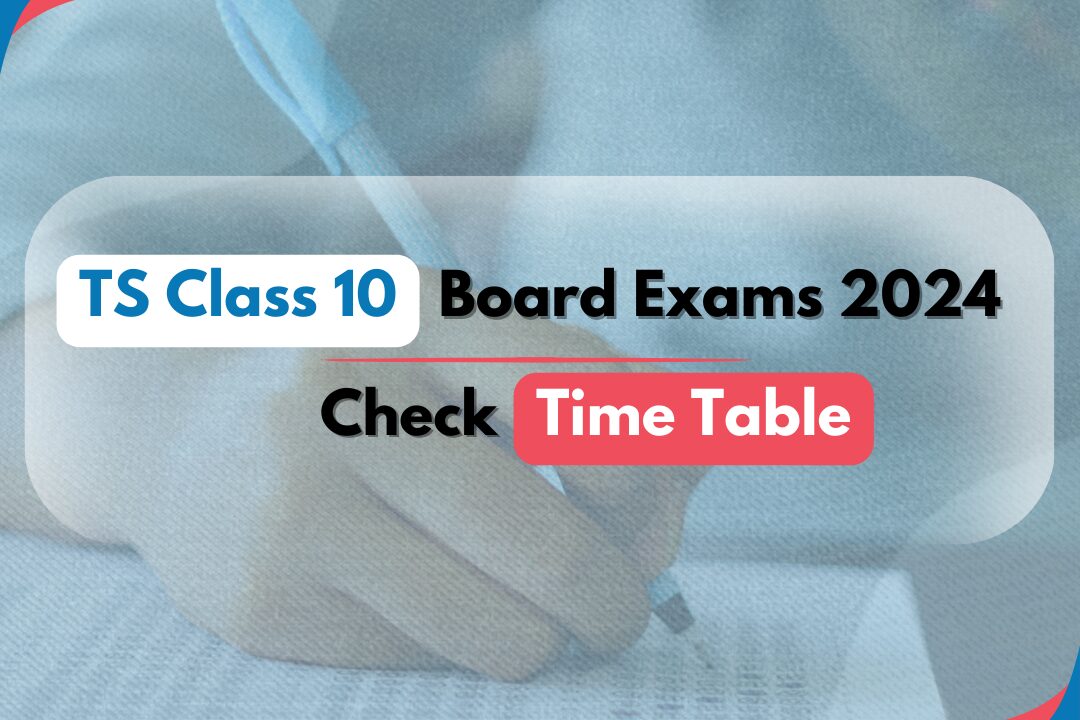
TS 10th Class Exam Time Table – 2024 | Download PDF

Best Summer Programs For High School Students In India | 2024

Uses of Convex Mirror: Definition, Applications and Characteristics
Recent articles.

Lets Connect!
Program Interested In MPC + SAT + PB MEC + SAT + PB SAT + Profile Building(PB) UG in Abroad

IMAGES
VIDEO
COMMENTS
1. Listen to other intros. Listen to intros that come before yours. If you can refer to someone else's point or two seamlessly in your intro, you'll impress people around. 2. Practice, but don't cram. People often go blank on some of the points or get nervous when they stand up to speak.
Begin with an attention-grabbing hook, such as a captivating anecdote, a thought-provoking question, a quote, or a vivid description. 3. Tell a Story: Weave your self-introduction into a narrative or story that highlights your experiences, values, or defining moments. Storytelling makes your essay relatable and memorable. 4.
Self Introduction Example for Students ( Self Introduction Sample) Self-introduction in English for School Students Example. Example 1: Hi, My name is Rohan, and I am a student in grade 9. I am originally from Delhi and have been living in Mumbai for the past 5 years. In my free time, I enjoy playing football and reading books.
Good example. I peel off my varsity basketball uniform and jump into the shower to wash away my sweat, exhaustion, and anxiety. As the hot water relaxes my muscles from today's 50 suicide drills, I mull over what motivating words I should say to my teammates before next week's championship game against Westmont High.
Good example. I wiped the sweat from my head and tried to catch my breath. I was nearly there—just one more back tuck and a strong dismount and I'd have nailed a perfect routine. Some students choose to write more broadly about themselves and use some sort of object or metaphor as the focus.
A student self introduction is an opportunity for you to talk about yourself, your personality, highlight your strengths, hobbies, skills, and experience, clearly and confidently. Whether you are introducing yourself to the university admissions committee, your classroom, your instructors, or anyone else, really, a self introduction gives you ...
Pointers for Writing a Self-Introduction Essay. A self-introduction essay might be one of the easiest essays to start. However, one needs to discover a few things to make of compose valuable liest. You can find a lot of tips web-based on how for write a self-introduction essay, but here are some tips which thou might find userful. 1.
Relate it to the present tense by describing how your past experiences led to your current interests. For example, as a teenager, you may have discovered a passion for marine biology because you enjoy fish and excel in science. 3. Consider your interests. Tell the college admissions officers about your interests.
For many, getting started is the hardest part of anything. And that's understandable. First, because it turns whatever you're doing into a reality, which raises the stakes. Second, because where you start can easily dictate the quality of where you end up. College essays have their own special brand of DTDT.
3. Make a positive, intentional impression. People form first impressions of others within seconds of meeting them, with or without their knowledge. Being intentional about the impression you make helps you take advantage of these first opportunities to meet people at college.
Situations where self-introduction is required: A story about yourself in a cover letter during the college application process. Presentation-story about yourself in front of the client when we present our product or service. Self-introduction during the speech to the audience. A short story about yourself during the acquaintance.
Tips for the right self-introduction for students in College, Summarize your professional status. The beginning of your self-introduction should contain your name and job title or experience. Elaborate on your experiences and achievements. Finally, end the conversation with a lead-in to the next section of the talk. Stick to the Context.
Question 1: What is the importance of self-introduction? Answer 1: The importance of self-introduction is that it brings out the uniqueness of each individual. This is because each individual is different and no two individuals can be alike. Moreover, it is a way of showing people what one knows about oneself.
Example 2: At the beginning of class, I would like to introduce myself. I am [name], and I am a first-year student. My major is [major]. I will take courses in [course 1] and [course 2]. I would also like to thank my advisor for helping me get into college and being such a great role model! Example 3: Hi, I'm [name], a first-year transfer ...
The students should be able to communicate freely and make an effort to address the audience smartly. Below are the best self introduction example for students. Example 1: Self Introduction for students during a college interview. Example 2: Self Introduction for students to a team.
These unique "tell me about yourself" examples will help you demonstrate your motivations and background at college and internship interviews. Dictionary Thesaurus ... "Tell Me About Yourself" Examples for College Students By Kate Miller-Wilson, B.A. , Staff Writer . ... During my freshman year of high school, I started a business ...
1. Go over your experiences repeatedly. Just like writing an essay, interview preparation is also a self-reflecting process. Start searching within yourself and see what kind of activities you have done in high school, which courses you are passionate about, and what areas you want to study.
When writing a student self introduction for college, start with a confident greeting and then state your name, course, and any relevant information. Share your interests or hobbies briefly to spark conversations. Finally, end with a positive closing statement that invites others to connect. 2.
Read through the prompt carefully and spend some time giving a thoughtful response. [6] It might be tempting to rush through the introductory post and reply with vague basics, but remember that taking the time to make thoughtful posts will make you feel more invested in the course. 7.
Setting the Tone. You should see the "tell me about yourself" prompt as an opportunity to show the interviewer your most important qualities and give them an initial sense of how you might contribute to the school's community. In any interview you have over the course of your college years and beyond, this prompt is meant to give the ...
5. Personal interests: Wrap up your self-introduction by mentioning a few personal interests or hobbies, which can help to humanize you and make you more relatable. For example, "In my free time, I love hiking and exploring new trails. I'm also a big fan of trying out new restaurants and cooking at home.".
We covered self introduction for students' templates for various contexts. Check the ones that you think are helpful for you. ... Be it in school or college, following the above tips for writing a self introduction we discussed above will help you get a good first impression and boost your self-confidence. 0 Shares. 10th standard CBSE SSC ...